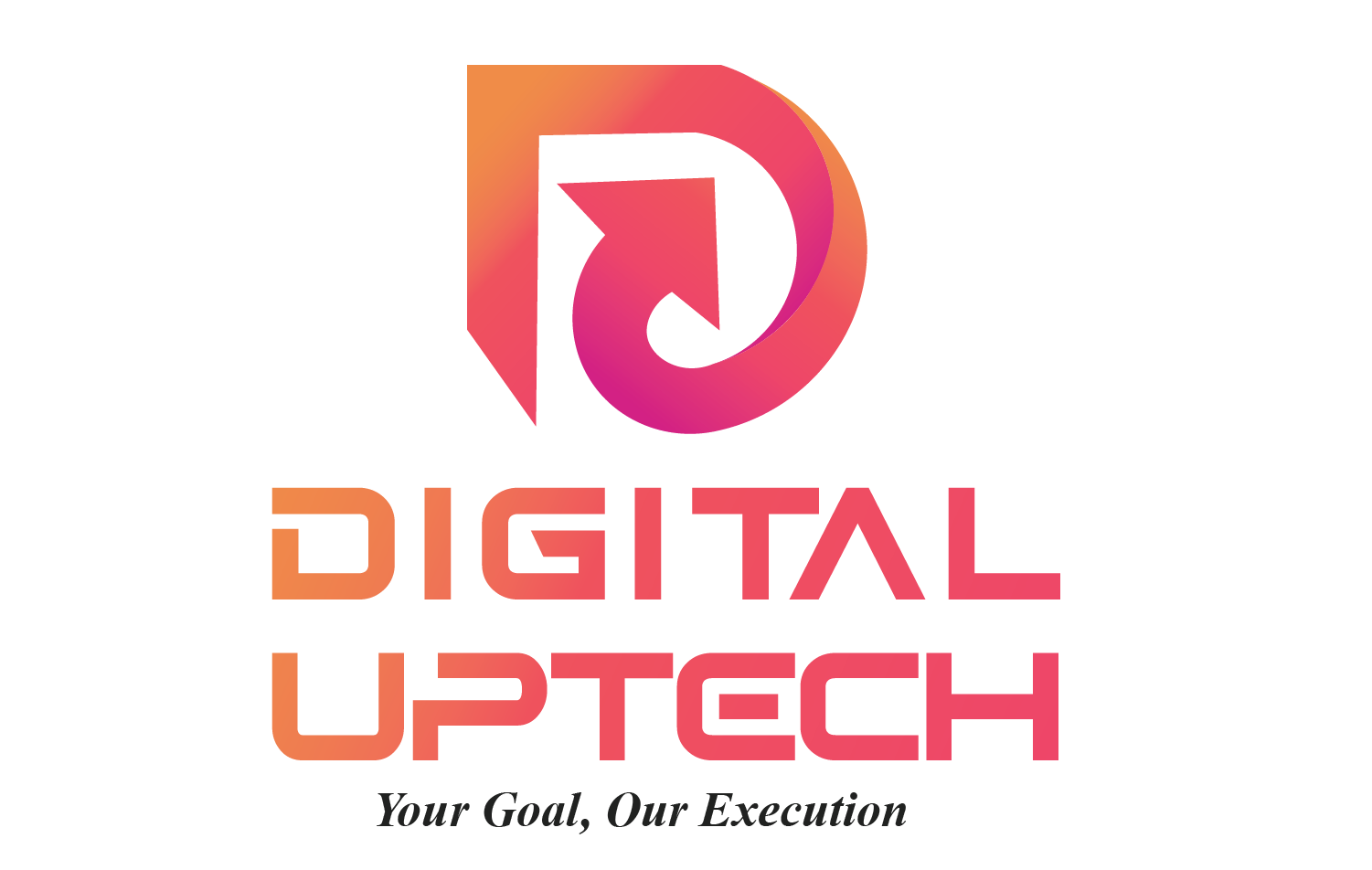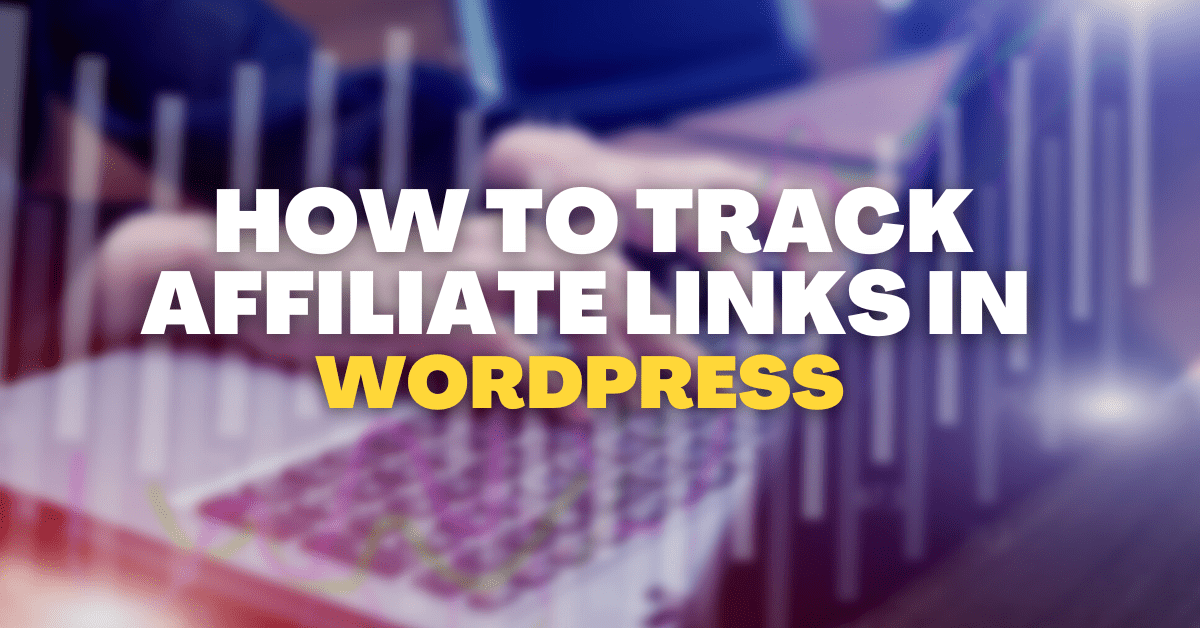Top Companies in London Who Provide SEO Services
Introduction
In today’s competitive digital environment, achieving a high position on Google is not just an option—it’s a necessity. With thousands of businesses in London competing for attention, professional SEO services are the backbone of sustainable online growth. Whether you’re a small local shop or a large enterprise, the right SEO agency can help you increase visibility, attract qualified traffic, and boost conversions.
If you’re looking for a trusted partner to elevate your online presence, explore our tailored solutions at Digital UpTech. We provide result-driven SEO services in London designed to help businesses grow smarter, faster, and stronger.
Why Choose an SEO Agency in London?
London isn’t just the capital of the UK—it’s also a global hub for business, technology, and digital marketing. With thousands of companies competing online, it’s one of the most competitive markets in the world. That’s why hiring a professional SEO agency in London can give your business the edge it needs to stay ahead.
Here’s why choosing a London-based SEO company makes sense:
1. Local Market Expertise
An SEO agency in London understands the unique dynamics of the UK audience. From targeting keywords like “SEO services in London” to optimizing for local search and Google Maps, they know how to reach customers in your area. This local knowledge gives you an advantage over agencies that operate without regional insight.
2. Access to Cutting-Edge Tools & Talent
London is home to some of the best SEO experts in the UK, many of whom use advanced tools, analytics platforms, and AI-driven SEO strategies. Partnering with a top SEO company in London means gaining access to this talent pool and technology, helping your brand stay ahead of algorithm changes.
3. Full-Service Digital Marketing Solutions
Unlike freelancers, many SEO agencies in London provide end-to-end digital marketing services. From technical SEO audits, content marketing, and link building to PPC campaigns and web design, they offer everything under one roof. This ensures your online presence is consistent and growth-focused.
4. Proven Track Record with UK Businesses
London SEO companies often work with a diverse portfolio of clients, from startups to global enterprises. Many agencies showcase case studies and success stories, proving their ability to deliver real results. This credibility helps you choose a partner that aligns with your industry and goals.
5. Competitive Edge in a Crowded Market
With more businesses investing in SEO than ever, competition in London is fierce. A dedicated SEO agency can help you identify opportunities, outperform competitors, and rank for high-value keywords that drive traffic and revenue.
6. Better ROI and Long-Term Growth
SEO is more than just improving rankings—it’s about creating steady traffic and increasing revenue. London agencies focus on long-term strategies that deliver measurable ROI, ensuring your investment pays off months and years down the line.
Factors to Consider Before Hiring an SEO Agency
Choosing the right SEO company is an important business decision.While London is home to many top SEO agencies, not all of them will be the right fit for your business. Before you sign a contract, it’s important to evaluate certain factors to ensure you’re investing in an agency that can actually deliver results.
Here are the key things to look for when hiring an SEO agency in London:
1. Proven Track Record and Case Studies
The most effective SEO agencies don’t just claim they can deliver results—they back up their claims with evidence. Look for companies that provide case studies, client testimonials, and portfolio examples. If an agency has worked with businesses in your industry, it’s a good sign they understand your challenges.
2. Transparency and Reporting
SEO is a long-term effort, and being open and clear is essential. Reputable agencies offer regular progress reports, often with dashboards showing keyword rankings, traffic growth, and ROI. This allows you to track exactly where your money is going and what results you’re achieving.
3. Customized SEO Strategies
Every business is unique. Be cautious of agencies that offer cookie-cutter SEO packages. The right partner should build a strategy tailored to your goals—whether that’s local SEO in London, international campaigns, or e-commerce optimization.
4. Pricing and ROI
SEO pricing in London can vary widely, from affordable SEO services for small businesses to premium packages for enterprises. While cost is a factor, it’s more important to focus on the value you get.The best SEO company is the one that provides measurable ROI, not just the lowest price.
5. Industry Experience and Expertise
Different industries require different approaches. For example, an e-commerce SEO expert will focus on product pages and category optimization, while a B2B SEO agency may prioritize lead generation. Always check if the agency has experience in your sector.
6. Communication and Support
SEO is a partnership. Choose an agency that values clear communication, responsiveness, and ongoing support. You should feel confident that your queries will be answered and your campaigns are being actively managed.
7. Certifications and Credibility
Look for certifications like Google Partner, HubSpot, or SEMrush. While not mandatory, these add credibility and show that the agency invests in continuous learning and best practices.
Top SEO Companies in London
London is home to some of the best SEO companies in the UK, offering services ranging from local SEO to enterprise-level strategies. Each agency brings its own strengths, making it essential to choose the one that best aligns with your business goals. Below is a list of the top SEO agencies in London that are delivering outstanding results in 2025:
1. Digital UpTech

Digital UpTech is one of the leading SEO agencies in London, specializing in delivering affordable SEO services, local SEO, and digital marketing solutions. Known for their tailored approach, Digital UpTech creates strategies that are designed around client goals—whether that’s boosting local visibility, driving e-commerce traffic, or achieving higher organic rankings.
Why choose Digital UpTech?
- Expertise in local SEO services London to help small and medium businesses dominate local searches.
- Full-service digital marketing, including SEO, web development, and PPC.
- Transparent reporting and measurable ROI.
- Flexible packages for businesses of all sizes.
If you’re looking for a partner that understands both UK search trends and international SEO strategies, Digital UpTech is a trusted name to consider.
2. Bird Marketing
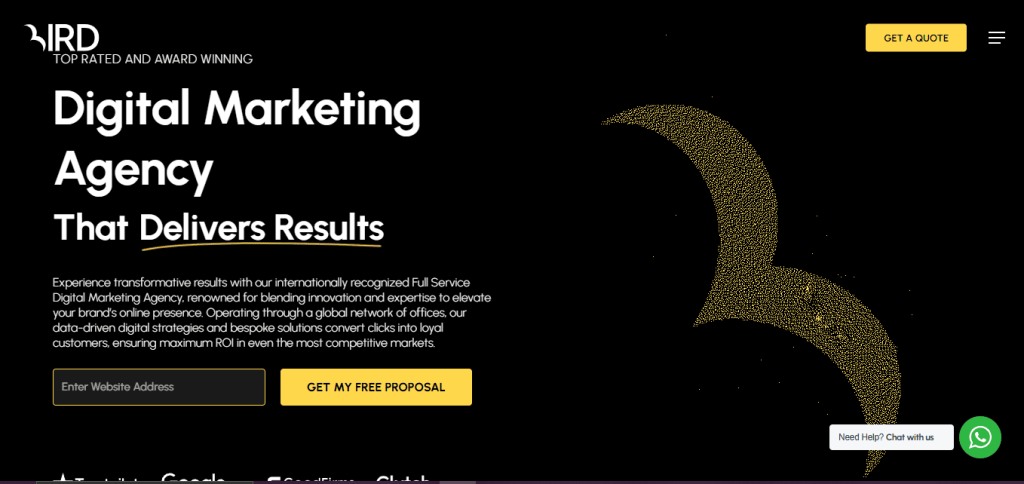
Bird Marketing is well-known for blending SEO services with web design and conversion optimization. Their London team focuses on building campaigns that improve both rankings and user experiences. Ideal for SMEs and growing brands that want a holistic digital presence.
3. Impression (Impression Digital)
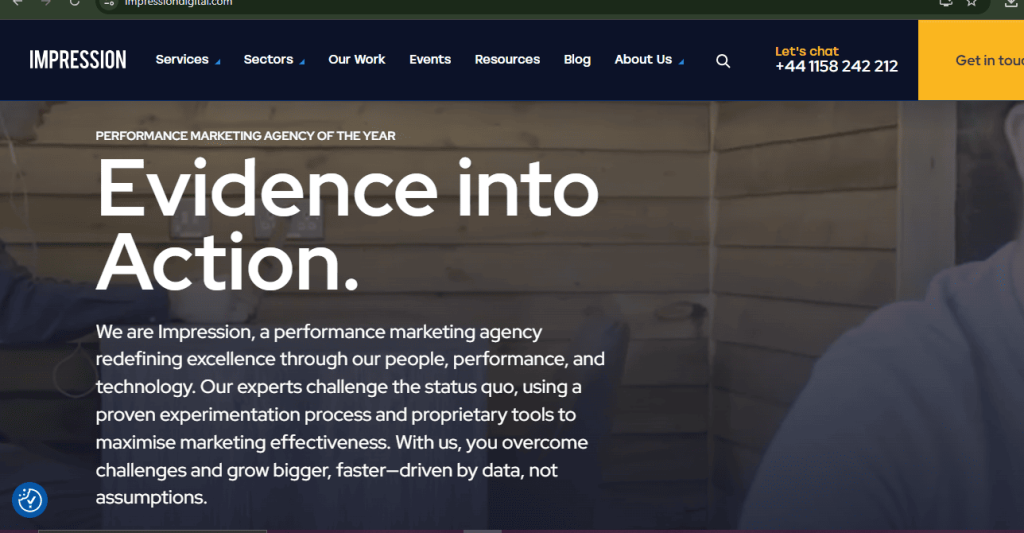
With offices in London, Impression is a highly respected digital marketing agency. They excel in technical SEO, digital marketing, and digital PR. Their data-driven, creative strategies make them a great choice for large businesses and enterprises.
4. ClickSlice

ClickSlice is a results-focused SEO company in London, known for its transparency and accountability. They provide real-time dashboards, flexible no-contract services, and even offer a money-back guarantee. Their strategies are ROI-driven, making them especially popular with startups and small businesses.
5. Blue Array
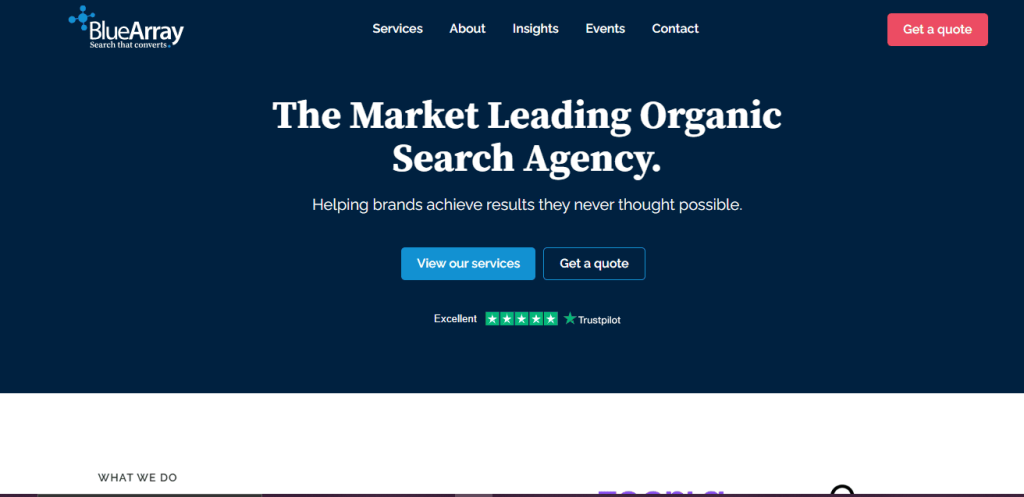
Blue Array is the UK’s largest dedicated SEO-only agency, with a strong presence in London. They operate using a “consulgency®” model—a mix of consultancy expertise and agency scalability. Trusted by enterprise-level clients, they specialize in technical SEO and large-scale campaigns.
6. Re:signal
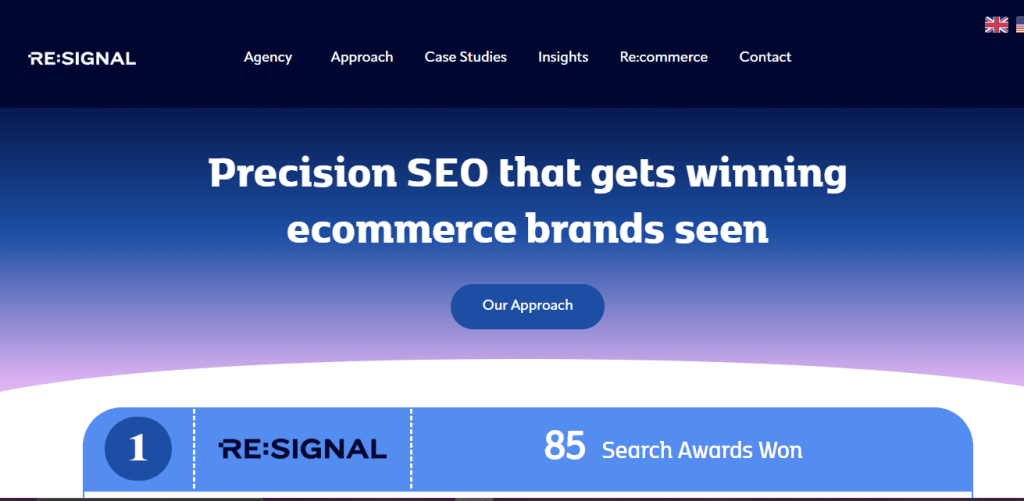
Re:signal is a London-based SEO agency that focuses heavily on e-commerce SEO strategies. They have worked with major UK retailers and are experts in driving organic visibility for online stores. Perfect for businesses that want to grow their digital sales.
7. Pearl Lemon
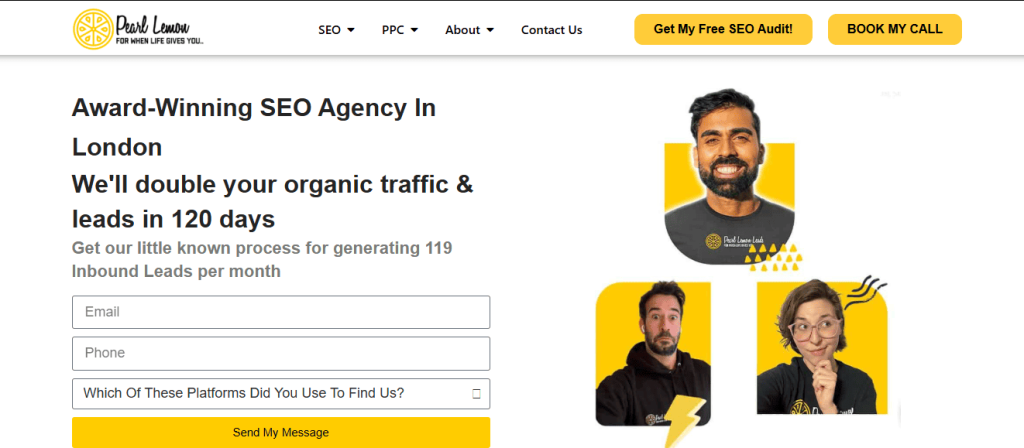
Pearl Lemon offers both local and international SEO services in London, helping businesses expand their reach. They are recognized for innovative SEO strategies designed to double organic traffic and boost long-term online growth.
Each of these top SEO companies in London offers unique strengths—whether you need local SEO, technical optimization, e-commerce SEO, or full-service digital marketing. For businesses seeking a reliable partner, starting with Digital UpTech provides a solid foundation for sustainable growth.
How Much Do SEO Services Cost in London?
The cost of SEO services in London can differ significantly based on the agency you choose, the extent of the work involved, and your business objectives. While freelancers may offer budget-friendly services, professional agencies in London provide structured strategies, transparent reporting, and long-term ROI—making them the preferred choice for serious businesses.
Here’s a breakdown of typical pricing:
1. Small Businesses & Startups
- Price Range: £500 – £1,500/month
- Services Included: Local SEO, keyword optimization, Google My Business setup, basic link building.
- Best For: Cafés, local shops, small service providers who want visibility in their area.
2. Medium-Sized Companies
- Price Range: £2,000 – £5,000/month
- Services Included: Technical SEO, on-page and off-page optimization, content marketing, local + national targeting.
- Best For: Growing businesses, e-commerce stores, and B2B companies wanting to scale.
3. Enterprise-Level SEO
- Price Range: £10,000+/month
- Services Included: Advanced SEO audits, international SEO, digital PR campaigns, dedicated SEO teams, and data-driven content strategies.
- Best For: Large corporations, multi-location businesses, or global brands with highly competitive markets.
4. Hourly SEO Consulting in London
- Price Range: £80 – £200/hour
- Services Included: Strategy sessions, technical audits, or troubleshooting specific issues.
- Best For: Businesses that need short-term expert advice without committing to a long-term contract.
Comparison Table of Top SEO Companies in London
| Company | Location | Core Strengths | Ideal For | Starting Price (Monthly) |
| Digital UpTech | London | Affordable SEO, local SEO, full-service digital marketing | SMEs, startups, growing businesses | £500+ |
| Bird Marketing | London | SEO, web design, conversion optimization | SMEs & growing brands | £1,000+ |
| Impression | London | Technical SEO, content strategy, digital PR | Large-scale businesses | £2,500+ |
| ClickSlice | London | ROI-driven, transparent, no-contract services | Startups & small businesses | £750+ |
| Blue Array | London | Enterprise SEO, scalable consultancy | Global enterprises | £5,000+ |
| Re:signal | London | E-commerce SEO specialists | Online retailers | £3,000+ |
| Pearl Lemon | London | Local & international SEO, traffic growth | SMEs & global businesses | £1,500+ |
Benefits of Hiring a London SEO Agency vs Freelancers
When it comes to improving your online visibility, businesses often face a crucial decision: hire a professional SEO agency in London or work with a freelancer. While both options have their advantages, choosing a reputable SEO company in London often delivers greater long-term value.
1. Expertise and Specialized Skills
Freelancers may have niche knowledge in certain areas like keyword research or content writing, but a London-based SEO agency brings together a full team of specialists. From technical SEO experts to link-building strategists and local SEO consultants, agencies provide a wider range of skills under one roof.
2. Access to Advanced Tools and Resources
Most professional SEO agencies in London invest in premium tools such as SEMrush, Ahrefs, Moz, and Screaming Frog. These tools allow for in-depth audits, competitor analysis, and performance tracking—resources that many freelancers can’t afford or may not use extensively.
3. Scalability and Consistency
Freelancers often work on multiple projects at the same time, which can limit their availability and scalability. On the other hand, London SEO companies have dedicated teams and structured processes, ensuring consistent delivery even as your business grows.
4. Local Market Knowledge
An SEO agency in London understands UK search trends, local consumer behavior, and regional competition, making them better equipped to build effective strategies for London-based businesses. Freelancers, especially if working remotely from other regions, may lack this local SEO insight.
5. Accountability and Reporting
Professional agencies like Digital UpTech provide transparent reports, measurable KPIs, and regular performance updates. This ensures you know exactly where your investment is going. Freelancers may not always have the resources or time to deliver such detailed reporting.
6. Long-Term ROI and Business Growth
While freelancers may appear more cost-effective upfront, SEO is a long-term investment. Partnering with a trusted SEO company in London often results in higher ROI, stronger brand visibility, and sustained organic traffic growth compared to short-term freelancer efforts.
Conclusion
Choosing the right partner from the top SEO companies in London can be the difference between being invisible online and becoming a market leader. While agencies like Bird Marketing, Impression, and ClickSlice each bring valuable expertise, the ultimate choice depends on your business goals, budget, and growth ambitions.
If you’re a startup looking for affordable SEO services in London, or a growing business aiming to dominate search results, it’s important to select an agency that combines local expertise, proven strategies, and transparent reporting.
That’s where Digital UpTech stands out. Unlike many agencies that lock clients into one-size-fits-all packages, Digital UpTech provides tailored SEO solutions designed around your unique business needs. From local SEO optimization to full-service digital marketing, our mission is to help London businesses achieve measurable growth and long-term ROI.
Whether you want to increase local visibility, grow your e-commerce sales, or compete nationally, Digital UpTech is your trusted partner for success.
Whether you want to increase local visibility, grow your e-commerce sales, or compete nationally, Digital UpTech is your trusted partner for success.
Ready to grow your business with the best SEO agency in London?
Visit Digital UpTech today and let’s start building a strategy that puts your brand at the top of Google rankings.
FAQs
1. What are the best SEO companies in London?
Some of the top SEO agencies in London include Digital UpTech, Bird Marketing, Impression, ClickSlice, Blue Array, and Re:signal. Each offers different strengths, from local SEO services to enterprise-level SEO strategies.
2. Why should I hire an SEO agency in London?
Hiring a London-based SEO agency ensures you get experts who understand UK search trends, local competition, and industry-specific strategies. Agencies like Digital UpTech also provide affordable SEO services tailored to startups and SMEs.
3. How much does SEO cost in London?
The cost of SEO services in London typically ranges from £500 to £5,000 per month, depending on the scope of work. Small businesses often spend between £500–£1,500, while larger companies may invest £5,000+ for enterprise SEO campaigns.
4. Which company offers affordable SEO services in London?
Digital UpTech is known for delivering affordable SEO services in London without compromising quality. They provide tailored packages designed for startups, SMEs, and growing businesses.
5. How do I choose the right SEO company for my business?
When selecting an SEO agency in London, consider factors like their experience, client reviews, pricing, and whether they provide customized SEO strategies. Look for transparency in reporting
6. Do SEO companies in London offer local SEO?
Yes. Many London SEO agencies specialize in local SEO services, helping businesses rank higher on Google Maps and in local search results. Digital UpTech, for example, offers local SEO packages designed to increase visibility in specific areas of London.
Who Offers Reliable Website Maintenance Services in London?
Introduction
In today’s competitive digital world, a well-maintained website is essential for any business in London. Regular website maintenance services ensure your site stays secure, fast, and user-friendly—helping you protect customer data, prevent downtime, and deliver a seamless browsing experience. From security monitoring and regular backups to performance optimization and content updates, ongoing website management services play a crucial role in building trust with your audience.
For businesses in London, where online competition is intense, having a reliable partner for professional website maintenance means more than just fixing errors—it’s about keeping your brand visible, secure, and performing at its best. This guide will help you discover who offers reliable website maintenance services in London, so you can choose the right provider to keep your site running smoothly.
What Does Website Maintenance Include?
When it comes to building a strong digital presence, investing in website maintenance services is just as important as launching the website itself. Many London businesses underestimate the need for ongoing website management, but without regular care, even the most professional websites can suffer from poor performance, security risks, and outdated content.
A reliable website maintenance package typically covers the following essentials:
Regular Updates & Backups
Websites powered by platforms such as WordPress, Shopify, or custom CMS need constant updates. Professional website maintenance services ensure that your themes, plugins, and core software remain up to date. In addition, scheduled website data backups protect your business from accidental data loss, server crashes, or cyberattacks.
Security Monitoring & Malware Protection
Cyber threats are on the rise, especially for ecommerce and corporate websites. With proper website security maintenance, your site is regularly scanned for malware, monitored for suspicious activity, and protected with SSL certificates and firewalls. This proactive approach not only protects your data but also builds customer trust.
Performance Optimization & Uptime Monitoring
User experience is directly linked to how fast and stable your site performs. Website performance optimization includes fixing broken links, optimizing images, and ensuring mobile responsiveness. Reliable providers also conduct uptime monitoring so your website is always accessible to customers—something crucial for competitive London businesses.
Content Updates & CMS Support
Keeping your website content fresh is essential for both SEO and customer engagement. Website support services often include adding new blog posts, updating product listings, or editing existing pages. A dedicated team can manage your CMS effectively, ensuring that content changes don’t disrupt your site’s structure.
Bug Fixing & Technical Support
From broken forms to compatibility issues, technical errors can damage user trust. Ongoing technical support ensures these issues are resolved quickly. A reliable website maintenance service provider in London offers 24/7 support, so your business never misses out on opportunities due to downtime.
Reporting & Analytics
Many website management services also provide regular reports on performance, security, and SEO improvements. This transparency helps business owners track progress, measure ROI, and make informed decisions about their online strategy.
Why London Businesses Need Reliable Website Maintenance
London is one of the most competitive business hubs, and customer expectations are higher than ever. Here’s why professional website maintenance services are crucial for businesses in the city:
Data Protection & GDPR Compliance – Secure websites protect customer information and keep your business compliant with strict data protection laws.
Competitive Advantage – With thousands of businesses online, website speed optimization and uptime monitoring make sure you don’t lose customers to faster competitors.
Customer Trust & Professional Image – A website with broken links or outdated content looks unprofessional. Reliable maintenance shows your audience that your brand is active and trustworthy.
SEO Benefits – Search engines reward websites that are updated, fast, and secure, helping you rank higher in local search results.
Time & Resource Savings – By outsourcing to a reliable service provider in London like Digital UpTech, you can focus on growing your business while experts handle the technical work.
Qualities of a Reliable Website Maintenance Service Provider
Not all website maintenance companies in London offer the same level of service. Choosing the wrong provider can lead to wasted money, downtime, and missed opportunities. To make the right decision, here are the qualities you should look for in a reliable website maintenance service provider:
Proven Experience & Portfolio
Look for a team that has handled multiple industries and platforms, from WordPress and Shopify to custom-built sites. Experience ensures your provider can anticipate problems and deliver quick solutions.
24/7 Monitoring & Technical Support
A reliable website requires constant uptime monitoring and round-the-clock support. Whether it’s a broken plugin or a sudden security breach, you need experts available at all times
Transparent Pricing & Flexible Packages
Clear pricing builds trust. The best providers offer website maintenance packages that are tailored to your needs—whether you’re a small business, ecommerce store, or enterprise
Expertise Across Platforms
Your provider should be skilled in multiple CMS platforms, ecommerce solutions, and custom sites. This ensures seamless updates, bug fixes, and website performance optimization no matter the setup
Strong Client Reviews & Testimonials
Before choosing a provider, check their customer feedback. Positive reviews reflect a proven track record of delivering professional website maintenance services.
Why Digital UpTech Stands Out in London
At Digital UpTech, we combine all these qualities to provide unmatched website support services for London businesses. Here’s why clients trust us:
⦁ A team of experts with proven experience in WordPress, Shopify, and ecommerce website maintenance.
⦁ 24/7 monitoring and technical support to keep your site secure and running smoothly.
⦁ Affordable and transparent website management packages, with no hidden costs.
⦁ Tailored solutions for startups, SMEs, and large corporations.
⦁ A strong reputation backed by positive client reviews and successful case studies.
With Digital UpTech, you get more than just website maintenance services—you get a long-term partner dedicated to helping your business grow online.

Reliable Website Maintenance Services in London
When it comes to reliable website maintenance in London, Digital UpTech stands out as a trusted partner for businesses of all sizes. We understand that every website is unique, which is why we provide tailored solutions that ensure your site remains secure, fast, and up to date.
Our comprehensive website management services cover everything you need to keep your digital presence strong:
Regular Updates & Backups
We handle all CMS, plugin, and theme updates while performing regular data backups to safeguard your website from crashes or accidental data loss.
Security Monitoring & Malware Protection
Your website’s safety is our priority. Our team provides website security maintenance, including malware scans, firewall protection, and SSL certificate management to keep your site fully protected against cyber threats.
Performance Optimization & Uptime Monitoring
A slow or offline website means lost customers. With performance optimization and uptime monitoring, we ensure your site loads quickly, functions smoothly, and is always accessible.
Content Updates & CMS Support
From updating blogs and product listings to managing content in WordPress or Shopify, our website support services keep your site fresh and engaging for users and search engines alike.
Bug Fixing & Technical Support
Our dedicated technical team offers 24/7 support to fix issues such as broken links, plugin errors, or compatibility problems—ensuring uninterrupted performance.
Reporting & Analytics
We provide detailed reports on website health, performance, and SEO improvements, so you always know how your site is performing.
How Much Do Website Maintenance Services Cost in London?
The cost of website maintenance services in London varies depending on the size of your site, features, and level of support required. At Digital UpTech, we offer flexible packages designed to fit businesses of all sizes—from startups to large enterprises.
Here’s a breakdown of our website maintenance and design plans
| Plan | Features | Price |
|---|---|---|
| Basic Plan | – 1–5 Page Custom Website – Mobile Responsive Design – Basic Contact Form – On-Page SEO Setup – 1 Round of Revisions – 5 Days Delivery Time – Free Hosting (1 Month) | $250 |
| Standard Plan | – Up to 10 Custom Pages – Fully Responsive Design – CMS Integration (WordPress) – Advanced Contact/Inquiry Form – Basic Speed Optimization – On-Page SEO + Meta Tags – Google Maps Integration – 2 Rounds of Revisions – 7–10 Days Delivery | $350 |
| Premium Plan | – 20+ Pages or Ecommerce Website – Custom UI/UX Design – CMS or Custom Admin Panel – Payment Gateway Integration – Blog Setup – Speed Optimization + Security Setup – SEO Optimization (Full On-Page SEO) – Chatbot or Live Chat Integration – 3 Rounds of Revisions – 14–20 Days Delivery – Ongoing Maintenance (Optional) | $500 |
Conclusion
In today’s fast-paced digital world, businesses in London cannot afford to ignore the importance of professional website maintenance services. From security monitoring and performance optimization to content updates and technical support, ongoing maintenance ensures your website stays secure, fast, and competitive.
Choosing the right partner makes all the difference. At Digital UpTech, we provide reliable website maintenance services in London tailored to the needs of startups, small businesses, and enterprises. Our dedicated team ensures your website is always up to date, protected against threats, and optimized for growth.
Don’t let downtime, outdated content, or security issues hold your business back.
Take the first step towards a secure, optimized, and high-performing website today. Contact Digital UpTech and discover how our website maintenance packages can keep your business ahead in London’s competitive market.
Frequently Asked Questions (FAQs)
- What are website maintenance services?
Website maintenance services include regular updates, security monitoring, data backups, performance optimization, bug fixing, and content updates. These services ensure your website remains secure, fast, and user-friendly. - Why do businesses in London need website maintenance?
London businesses face tough online competition. Reliable website maintenance services in London help protect customer data, ensure GDPR compliance, improve SEO rankings, and provide customers with a seamless browsing experience. - How much do website maintenance services cost in London?
The cost of website maintenance in London varies depending on your website size, features, and level of support. At Digital UpTech, our website maintenance packages start from affordable rates and include updates, security checks, backups, and performance monitoring tailored to your business needs. - How often should a website be maintained?
Websites should be maintained regularly—at least once a month. However, high-traffic ecommerce or corporate sites often require weekly updates, security scans, and performance monitoring to avoid downtime or cyber threats.
- Does website maintenance improve SEO?
Yes. Regular website updates, speed optimization, fixing broken links, and fresh content directly improve your SEO rankings. Search engines favor websites that are secure, fast, and user-friendly. - What does Digital UpTech include in its website maintenance packages?
At Digital UpTech, our website management services include:
⦁ Regular updates & backups
⦁ 24/7 security monitoring & malware protection
⦁ Website speed optimization & uptime monitoring
⦁ CMS and content updates
⦁ Bug fixing & technical support
⦁ Detailed monthly performance reports
- Can Digital UpTech help with ecommerce website maintenance?
Absolutely . We specialize in Shopify, WooCommerce, and custom ecommerce websites, offering services like payment gateway maintenance, inventory updates, speed optimization, and ongoing security monitoring.
- How do I get started with Digital UpTech’s website maintenance services?
Getting started is simple! Contact Digital UpTech today to discuss your requirements. Our team will recommend the best website maintenance package for your business and ensure your site runs smoothly, securely, and efficiently.
Jasper AI for LinkedIn: The Best AI Tool to Create Engaging Posts
Introduction
LinkedIn is the world’s largest platform for professionals and businesses. It has become the go-to place for networking, lead generation, and personal branding. But creating consistent and engaging LinkedIn posts is not always easy. Many professionals struggle with many ideas, tone, and time.
This is where Jasper AI for LinkedIn posts makes a difference. Jasper AI is an advanced writing assistant that helps you write powerful LinkedIn content in minutes. It generates post ideas, drafts, and captions that match your voice. By using Jasper AI, you can save time, build authority, and engage your audience more effectively.

What is Jasper AI?
Jasper AI is an advanced AI writing assistant designed to create professional and engaging content. It uses natural language processing to generate clear, creative, and audience-focused text. Many marketers and business owners use Jasper AI for social media, blogs, and especially LinkedIn posts.
Unlike generic tools, Jasper AI comes with templates for LinkedIn content, making it easier to craft posts that drive attention and engagement. You can choose the tone, style, and intent, and Jasper will deliver content that fits your brand voice. This helps professionals sound authentic while saving hours of manual writing.
Jasper AI is also widely used for content marketing, B2B LinkedIn campaigns, and personal branding. It reduces writer’s block, suggests viral post ideas, and repurposes existing content into powerful LinkedIn updates. With Jasper AI, creating consistent LinkedIn posts becomes simple, fast, and effective.
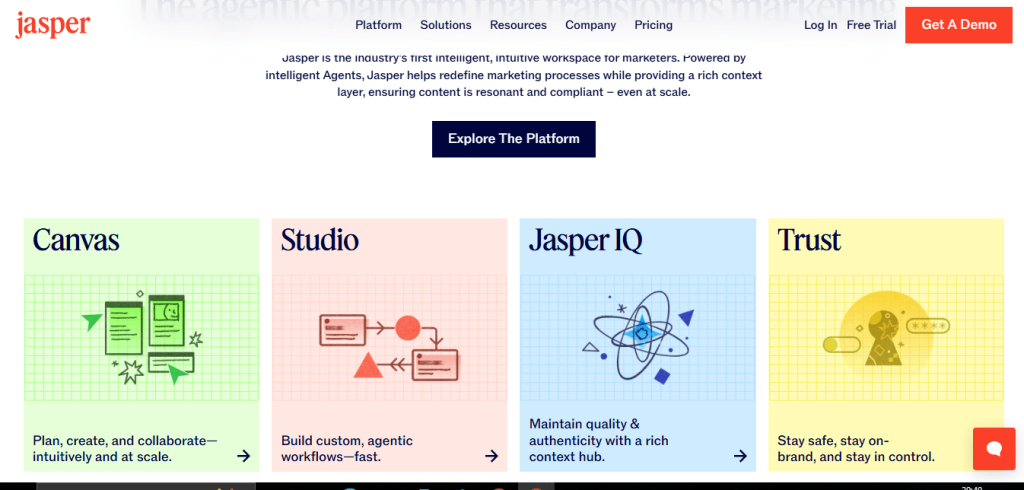
Why Use Jasper AI for LinkedIn Posts?
Creating quality LinkedIn posts takes time, effort, and creativity. Many professionals struggle to write engaging content while managing their busy schedules. Jasper AI for LinkedIn solves this challenge by generating ready-to-use posts that are professional, creative, and audience-focused.
With Jasper AI, you can maintain a consistent posting schedule, which is essential for building authority on LinkedIn. It provides fresh ideas, hooks, and captions that increase visibility and engagement. This means your content stands out in the LinkedIn algorithm and reaches more people.
Another reason to use Jasper AI is its ability to match your brand tone. Whether you want your LinkedIn post to sound formal, friendly, or motivational, Jasper AI adjusts the style to suit your audience. This ensures that every post feels authentic while still being optimized for engagement.
Features of Jasper AI for LinkedIn Posts
AI-Powered Templates
Jasper AI offers pre-built LinkedIn post templates that make writing faster. These templates are designed to create professional updates, thought-leadership posts, and engaging captions.
Tone and Style Control
With Jasper AI, you can customize the tone of voice to match your brand. Whether you want your LinkedIn posts to be formal, friendly, or motivational, the AI adapts accordingly.
Content Repurposing
Jasper AI allows you to repurpose blog articles, news, or reports into LinkedIn posts. This feature helps in sharing consistent content without starting from scratch every time.
Post Idea Generation
One of the most useful features is AI-driven idea generation. Jasper suggests creative LinkedIn post ideas, hooks, and engaging captions to eliminate writer’s block.
SEO and Engagement Optimization
Jasper AI is built with marketing and engagement in mind. It creates posts that attract attention, encourage comments, and improve your LinkedIn reach.
How to Create LinkedIn Posts with Jasper AI (Step-by-Step)
Step 1: Select the Right Template
Begin by opening Jasper AI and selecting a LinkedIn post template. This gives you a structured format for writing updates, professional stories, or thought-leadership content. Templates save time and keep your writing focused.
Step 2: Define Your Topic and Goal
Decide what you want to share. Is it industry insights, personal branding, or company news? Enter your topic, target audience, and intended purpose into Jasper. The clearer your input, the better your output.
Step 3: Choose Tone and Style
Select the right tone of voice for your LinkedIn post. You can make it professional, casual, or motivational. Jasper AI adjusts to match your brand personality, helping your posts sound genuine and relatable.
Step 4: Generate Content Ideas
Click generate, and Jasper will provide multiple post ideas, hooks, and captions. These AI-driven suggestions help you avoid writer’s block and spark creativity.
Step 5: Refine and Personalize
AI content is a great starting point, but human touch is essential. Add your experience, insights, or a personal story to make the post relatable. This balance of AI + personal input creates authentic LinkedIn content.
Step 6: Optimize for Engagement
Before publishing, check for engagement elements. Add hashtags, questions, or a call-to-action to encourage likes, comments, and shares. Jasper can even suggest CTAs for higher interaction.
Step 7: Publish and Track Results
Once your post is ready, publish it on LinkedIn. Monitor performance through likes, comments, and impressions. The more you test, the more you’ll learn how Jasper AI fits into your LinkedIn content strategy.
Best Practices for Using Jasper AI on LinkedIn
Using Jasper AI for LinkedIn posts can save time and boost creativity, but it works best when combined with a human touch. AI is powerful, yet authenticity is what makes content resonate on LinkedIn.
To get the most out of Jasper AI, focus on balancing automation with personal insights. Let Jasper generate ideas and drafts, but always refine the content to match your story, brand, and voice. This ensures your posts sound genuine, not robotic.
Another important practice is to optimize posts for engagement. LinkedIn rewards content that sparks conversation. Adding questions, polls, or CTAs encourages interaction and increases visibility in the LinkedIn algorithm.
Quick Best Practices
- Always add a personal story or experience.
- Keep sentences short and easy to read.
- Use hooks in the first two lines to grab attention.
- Add relevant hashtags for reach.
- Mix AI-generated content with authentic insights.
- Post consistently to build authority and trust.
Benefits of Jasper AI for LinkedIn Marketing
Saves Time and Reduces Effort
Writing LinkedIn posts manually can be time-consuming. With Jasper AI for LinkedIn, you can create posts in minutes. The tool generates high-quality drafts, giving you more time to focus on networking and business growth.
Builds Consistency in Posting
Consistency is key on LinkedIn. Jasper AI helps you maintain a regular posting schedule by generating fresh ideas, hooks, and captions. This keeps your profile active and visible in the LinkedIn algorithm.
Improves Engagement and Reach
Jasper AI is designed to create content that sparks interaction. By providing strong hooks, questions, and CTAs, it increases likes, comments, and shares. This boosts engagement and expands your reach across LinkedIn.
Enhances Personal Branding
Professionals and businesses use LinkedIn to build authority. Jasper AI helps you maintain a consistent brand voice while posting thought-leadership content. This makes your profile stand out and builds credibility.
Eliminates Writer’s Block
One of the biggest benefits is idea generation. Jasper AI suggests creative post ideas and content angles, helping you avoid writer’s block. You never run out of fresh, relevant topics to share.
Limitations to Consider
- Needs Human Editing – Jasper AI generates quality drafts, but you must refine them for accuracy, grammar, and flow. Without editing, posts may lack depth.
- Lacks Real Experience – AI cannot replicate personal stories, emotions, or unique experiences. LinkedIn thrives on authenticity, so you still need to add your voice.
- Risk of Generic Content – If you rely only on AI, your posts may sound repetitive or robotic. Adding creativity and storytelling is important.
- Dependent on Input Quality – Jasper AI performs best with clear and specific prompts. If your instructions are vague, the output may not match your intent.
- Limited Personalization – While Jasper adjusts tone, it may not fully capture your brand identity. Manual tweaks ensure posts align with your personality.
- Subscription Cost – Jasper AI is a premium tool. Its pricing may be high for beginners or small businesses with limited budgets.
- AI can’t Replace Strategy – Jasper helps with writing, but it cannot plan your full LinkedIn content strategy. You must decide when and how to post.
- Potential Overreliance – Depending too much on AI can reduce your natural creativity. Use Jasper as support, not as a complete replacement.
- Not Always Perfect with Context – Jasper may occasionally misinterpret topics or trends, requiring human adjustments for relevance.
Jasper AI vs Manual Writing for LinkedIn
| Aspect | Jasper AI for LinkedIn Posts | Manual Writing for LinkedIn Posts |
| Speed | Creates posts in minutes with AI templates | Takes longer, requires brainstorming and drafting |
| Creativity | Generates ideas and hooks instantly, but may sound generic | Offers unique insights, personal stories, and originality |
| Consistency | Ensures regular posting with AI-driven ideas | Depends on discipline and available time |
| Tone & Style | Can adapt tone (professional, casual, motivational) but needs refining | Naturally matches your authentic voice and brand identity |
| Cost | Requires a paid subscription | Free, but the time investment is higher |
| Personalization | Limited without manual edits | High, since posts reflect real experience |
| Engagement | Optimized for reach with AI-driven CTAs and hashtags | Builds deeper trust through authentic storytelling |
Notes
- Jasper AI is best for professionals who need speed, idea generation, and help maintaining a posting schedule.
- Manual writing works better when authenticity, personal stories, and brand trust are the main goals.
- The most effective approach is to combine both: use Jasper AI for structure and ideas, then add personal insights for authenticity.
Conclusion
LinkedIn is one of the best platforms for building authority, growing a network, and generating leads. But writing consistent, engaging posts can be challenging. Jasper AI for LinkedIn posts makes this process easier by generating ideas, hooks, and drafts in minutes.
The tool saves time, improves consistency, and helps professionals maintain a strong LinkedIn presence. However, the most powerful results come when you combine Jasper AI with your own stories, insights, and experiences. This balance ensures your posts are both authentic and optimized for engagement.
If you want to stand out on LinkedIn, Jasper AI can be your writing partner. Use it to create professional posts, build trust with your audience, and take your LinkedIn marketing strategy to the next level. For professional support in content creation or LinkedIn growth, contact us today, and let’s take your brand forward.
FAQs
1. How does Jasper AI help with LinkedIn posts?
Jasper AI helps in quickly generating professional and compelling LinkedIn content. It provides hooks, captions, and post ideas that save time and boost visibility.
2. Is Jasper AI useful for B2B LinkedIn marketing?
Yes. Many companies use Jasper AI to create B2B-focused LinkedIn posts, share industry updates, and build strong professional authority.
3. What is the cost of Jasper AI?
Jasper AI is a paid writing assistant with multiple subscription plans. The price depends on usage, but it is often worth the investment for consistent LinkedIn posting.
4. Can Jasper AI match my brand voice?
Jasper AI allows you to define the tone and style for your LinkedIn posts. You can make the content formal, casual, or motivational, and then refine it for authenticity.
5. Which is better for LinkedIn posts: Jasper AI or ChatGPT?
Jasper AI is built for marketing and social media content, making it stronger for LinkedIn. ChatGPT is more general, while Jasper’s templates focus on engagement and growth.
6. Does Jasper AI suggest hashtags and CTAs for LinkedIn?
Yes. Jasper AI can recommend relevant hashtags, calls-to-action, and questions to make your LinkedIn posts more interactive and engaging.
How to Create a Freelancer Portfolio Website in 2025 (Beginner’s Guide)
Introduction
How to Create a Freelancer Portfolio Website is a common question for many individuals who choose freelancing as a profession. They often value independence in their work life while aiming for financial stability. Professional trajectories highlight that career growth for freelancers is very different from office workers. When you work freelance, your portfolio is one of the most important tools to advance your career and grow online.
This article explores freelance portfolios and why they are essential. With examples, you can learn how to create a strong presence that attracts clients and gigs. A freelancer builds a brand through services, brands create stories, and those stories are told by using a portfolio. The telling of a compelling story with visuals and text can be powerful and capture potential client interest.
A skilled freelancer shows detail in work, stays oriented toward goals, and delivers delightful results to the world. The essence of a portfolio is to highlight work in a way that combines story, visuals, and text. By doing so, freelancers use important tools to create powerful impressions, build a professional image, and demonstrate their services with clarity.
WHAT IS A FREELANCER PORTFOLIO?
A freelancer’s portfolio is more than just a selection of their finest work. It serves as a professional tool that showcases their abilities, creativity, and experience.. A portfolio gives potential clients confidence in a freelancer by showing evidence of employability. Freelance professionals use portfolios to demonstrate value, credibility, and the choice that sets them apart in business. A spectacular portfolio allows professionals to present work, projects, samples, and completed tasks in a way that looks compelling and captivating through visuals and storytelling.
Future clients often feel unfamiliar with freelancers. They want trust, proof, and details before deciding to hire. They review testimonials, resumes, and client feedback to verify authenticity. A portfolio helps to gain trust and demonstrate growth, revenue, and essential qualities. It shows that a freelancer is confident, avoids mistakes, and delivers on promises. Portfolios convince clients that hiring is the right choice and provide professionals with new opportunities.
A portfolio demonstrates two things. First, it shows a value proposition through skills, creativity, and work that is completed and displayed. Second, it provides proof that a freelancer can deliver and make a killer impression. By presenting resumes, industry experience, professional standards, and employability evidence, a portfolio shows why hiring a freelancer is informed, credible, and essential. Resumes alone may suffice in standard industries, but in freelance professions, a curated portfolio is what truly helps to gain trust and growth.

Define Your Goals and Target Audience
Understanding the clientele and audience is the first step when creating a freelance portfolio that works. A freelancer needs to identify potential clients, understand their requirements, and showcase samples that highlight successful projects. Looking at industry-standard freelancer portfolios helps identify gaps and provide a clear picture of what impresses clients. By keeping in mind the portfolio details, you can achieve results that gain trust and recommend you to others.
A professional portfolio is not just about previous projects; it is also about how you cover people’s expectations. Professionals must display completed works, determine their clientele, and consider what makes a client hire them again. By looking at successful samples, a freelancer can understand what clients expect and ensure their portfolio works better than others. The more you impress potential clients, the higher the chances of creating long-term growth.
- Identify gaps in people’s portfolios and cover them with your work.
- Achieve results by showing completed projects that match requirements.
- Identify your target clientele and create a portfolio that appeals to them.
- Impress clients so they recommend you to others.
- Look at industry-standard freelancer samples to understand expectations.
Choose the Right Platform for Your Portfolio Website
| Platform | Pros | Cons |
| WordPress | Highly customizable with thousands of plugins and themes. Scalable for long-term growth. Strong SEO capabilities. | Requires hosting setup, updates, and technical knowledge for advanced features. |
| Wix | Easy drag-and-drop builder. Beginner-friendly with ready-to-use templates. Quick setup with minimal learning curve. | Limited flexibility compared to WordPress. Not ideal for complex or large-scale sites. |
| Squarespace | Sleek, modern templates ideal for creatives. All-in-one hosting, templates, and support. | Less customizable. It can be expensive for premium plans. Limited third-party integrations. |
| Webflow | Advanced design control with responsive layouts. Great for professionals wanting custom portfolio design. Strong scalability. | Steeper learning curve. Pricing can be higher for freelancers just starting. |
Select a Professional Domain Name and Hosting
When building your freelance portfolio website, choosing the right domain name and hosting is one of the most important decisions. A custom domain (like yourname.com) gives your portfolio a professional look, builds trust with clients, and helps you stand out in competitive freelance markets. On the other hand, reliable hosting ensures your website loads quickly, stays secure, and provides a smooth user experience.
Below is a simple guide to help you pick the best domain name and hosting provider for your portfolio website:
| Aspect | Tips / Options | Why It Matters | Examples |
| Domain Name | Keep it short & simple | Easy to remember and type | mohibdesigns.com |
| Use your name or brand | Builds personal branding & credibility | hafizmohib.com | |
| Avoid numbers & hyphens | Prevents confusion and miscommunication | creativeportfolios.com | |
| Add relevant keywords | Improves SEO and clarity | mohibfreelancedesign.com | |
| Choose the right extension | .com is professional, .design or .studio are niche-specific | mohib.studio | |
| Hosting | Bluehost | Affordable and beginner-friendly | Bluehost.com |
| SiteGround | Fast and reliable with strong support | SiteGround.com | |
| Hostinger | Budget-friendly, good uptime | Hostinger.com | |
| Kinsta | Premium hosting for scalability | Kinsta.com |
Selecting the right domain name and hosting provider is essential for building credibility and attracting clients online. A strong, memorable domain boosts your brand, while a reliable hosting service ensures your portfolio is always accessible. Together, they lay the foundation for your freelancing success and long-term growth.
Design a Clean and User-Friendly Layout
A clean and user-friendly layout plays a vital role in how potential clients view your portfolio website. Keeping the design minimal and professional ensures your work stands out without unnecessary clutter. A simple structure with clear fonts, balanced spacing, and a consistent color palette makes your portfolio more engaging and professional. This not only improves readability but also builds credibility and helps you make a strong first impression.
Equally important is having a responsive design that works across all devices. A mobile-friendly portfolio ensures visitors can easily navigate your work, whether they are on a phone, tablet, or desktop. Smooth navigation and quick access to key sections make your website intuitive and easy to explore. When clients find your portfolio simple to browse, it increases the chances of converting them into long-term opportunities.
Best Practices for a User-Friendly Layout
- Keep the design minimal and professional to highlight your work.
- Ensure your portfolio uses a responsive (mobile-friendly) design.
- Prioritize easy navigation with clear menus and structured sections.
- Improve readability with consistent headings, fonts, and spacing.
- Optimize visuals for fast loading speed and smooth performance.
A well-designed portfolio with a clean layout, responsive features, and user-focused navigation shows professionalism and creates a positive user experience that keeps clients engaged.
Essential Pages to Include in a Freelancer Portfolio Website
When building a freelancer portfolio website, having the right pages is crucial for making a strong impression on potential clients. Each page should be designed to showcase your professionalism, highlight your expertise, and guide visitors toward contacting you. A well-structured portfolio not only improves user experience but also boosts your SEO performance by covering important search intent keywords.
Key Pages Every Freelancer Portfolio Should Have
- Home Page – A short introduction with a professional headline that captures attention and communicates your niche immediately.
- About Me – Share your personal story, highlight your skills, and convey your values to build trust and authenticity.
- Portfolio / Work Samples – Showcase your best projects, case studies, and client results to demonstrate credibility and expertise.
- Services – List the services you offer so clients can easily understand how you can solve their problems.
- Testimonials / Reviews – Include social proof from past clients to build trust and increase conversions.
- Contact Page – Provide multiple ways for clients to reach you, such as a form, email address, and social media links.
- Optional: Blog Page – Publish valuable content to establish thought leadership, improve SEO visibility, and attract organic traffic.
A freelancer portfolio website with these essential pages ensures that potential clients find everything they need in one place — from your background and services to proof of expertise and easy contact options
Showcase Your Work Effectively
Your freelancer portfolio website should do more than list projects — it should prove your skills and build credibility. By combining high-quality visuals, screenshots, and compelling case studies, you can transform your portfolio into a powerful tool that convinces potential clients of your value. Short success stories backed with metrics and clear results will make your work stand out.
Best Practices to Showcase Your Work Effectively
- Use high-quality visuals and screenshots to display your work in a professional and engaging way.
- Write short case studies that highlight the problem, the solution you provided, and the results achieved.
- Highlight achievements with metrics such as increased sales, website traffic, or customer engagement.
Example Case Studies You Can Add
Website Redesign for a Local Business
- Problem: Outdated design and low traffic.
- Solution: Created a responsive website with clean navigation.
- Results: 70% increase in traffic within 3 months and 35% more inquiries.
Social Media Campaign for a Startup
- Problem: No brand awareness.
- Solution: Designed a targeted Instagram campaign with engaging visuals.
- Results: Gained 5,000+ followers and improved conversions by 20%.
E-commerce Store Development
- Problem: Client had no online presence.
- Solution: Built a custom Shopify store with SEO optimization.
- Results: Generated $15,000 in revenue in the first two months.
Showcasing your work this way not only demonstrates your skills, creativity, and problem-solving ability but also provides proof of measurable results, which is exactly what clients look for.
Add SEO Optimization for Better Visibility
A freelancer’s portfolio website becomes truly powerful when it is optimized for search engines. Strategic keyword placement in the title, headings, and meta description helps search engines understand your content, making it easier for potential clients to find you online. By focusing on SEO optimization, you improve not only visibility but also credibility in your niche.
To enhance your portfolio, make sure every image includes descriptive alt text, as this improves accessibility and boosts your chances of ranking in image search results. Another critical factor is site speed and mobile performance—a slow-loading website or one that isn’t responsive can drive potential clients away. Adding internal links to relevant sections, such as your services, case studies, or testimonials, also improves navigation and distributes ranking power across your site.
SEO Optimization Tips for Freelancer Portfolios
- Place keywords naturally in titles, headings, and meta descriptions.
- Use alt text for images to improve SEO and accessibility.
- Optimize site speed and mobile performance to enhance user experience.
- Add internal linking to guide visitors toward important pages like “Portfolio,” “Services,” and “Contact.”
Enhance Your Portfolio with Additional Features
A professional freelancer portfolio website can stand out by integrating smart features that improve user engagement and client trust. Adding a blog section allows you to share expertise, publish industry insights, and boost SEO performance with fresh content. A downloadable resume or CV gives clients quick access to your background and skills in a professional format, making it easier for them to evaluate your credibility.
Strong calls-to-action, such as a visible “Hire Me” button, guide potential clients to take immediate action. To further enhance communication, integrate a chatbot or contact form, ensuring quick responses and accessibility. These elements not only improve the user experience but also build confidence and encourage clients to connect with you directly.
Additional Features to Strengthen Your Freelancer Portfolio
- Integrate a blog to demonstrate expertise and improve SEO.
- Provide a downloadable resume or CV for credibility.
- Add a clear call-to-action like a “Hire Me” button.
- Use a chatbot or contact form for faster communication.
By incorporating these features, your portfolio becomes more interactive, client-focused, and effective at converting visitors into long-term opportunities.
Keep Your Portfolio Updated
An effective freelancer portfolio website is never static—it should evolve with your career. Regularly adding new projects showcases your latest work and proves that you are active in the industry. Updated case studies or visuals also help potential clients see the variety and quality of your skills over time.
Refreshing testimonials and client reviews ensure your portfolio always highlights relevant and trustworthy feedback. Likewise, updating your design and content keeps your website modern, mobile-friendly, and aligned with current industry standards. A fresh and dynamic portfolio not only strengthens your brand but also boosts visibility in search results.
Ways to Keep Your Portfolio Updated
- Add new projects to highlight recent achievements.
- Refresh testimonials to display current client experiences.
- Update design and content to stay professional and relevant.
Promote Your Freelancer Portfolio Website
Once your freelancer portfolio website is ready, the next step is to actively promote it so potential clients can discover your work. Share your portfolio link on LinkedIn, Behance, Dribbble, and other social media platforms to expand your reach and build credibility in your industry. These platforms are widely trusted by recruiters and businesses, making them perfect for attracting quality leads.
You should also include your portfolio link in email signatures and business cards to maximize everyday networking opportunities. Additionally, use guest posting, online collaborations, and backlinks to improve your website’s SEO and boost search engine visibility. Consistent promotion not only helps you gain exposure but also positions you as a professional freelancer clients can trust.
Effective Promotion Tips
- Share your portfolio on LinkedIn, Behance, Dribbble, and social platforms.
- Add the link to your email signature and business cards.
- Use guest posting and networking to build backlinks and authority.
Conclusion
Building a freelancer portfolio website is one of the most powerful steps you can take to attract clients, showcase expertise, and establish credibility in your niche. By defining your goals, selecting the right platform, choosing a professional domain, and designing a clean layout, you create a strong online presence that sets you apart from your competitors. Adding essential pages, optimizing for SEO, and promoting your portfolio through social media and networking further boost visibility and help you connect with the right audience.
A well-crafted portfolio not only highlights your skills but also proves your value through case studies, testimonials, and measurable results. Consistently updating your work ensures you stay relevant and trusted in a competitive freelancing market.
If you’re ready to take your freelancing career to the next level with a professional and conversion-focused portfolio, contact us for services today. We’ll help you design a portfolio website that not only impresses clients but also drives real opportunities for growth.
FAQs
Q1. Why is a freelancer’s portfolio website important?
A freelancer’s portfolio website helps showcase their skills, projects, and achievements professionally. It builds trust with potential clients and increases online visibility.
Q2. Which platform is best for creating a freelancer portfolio website?
Popular options include WordPress, Wix, Squarespace, and Webflow. The right choice depends on your budget, customization needs, and ease of use.
Q3. What should I include in my freelancer portfolio website?
Essential pages are: Home, About Me, Portfolio/Work Samples, Services, Testimonials/Reviews, and Contact. Adding a blog can also improve SEO and thought leadership.
Q4. How can I optimize my freelancer portfolio website for SEO?
Use keyword-rich titles and headings, add meta descriptions, optimize images with alt text, ensure mobile responsiveness, improve site speed, and use internal linking.
Q5. How can I promote my freelance portfolio website to attract more clients?
Share your portfolio on LinkedIn, Behance, Dribbble, and social media. Add it to email signatures, business cards, and use guest posting or networking to build backlinks.
LinkedIn Ads Specs 2025: Updated Ad Sizes, Formats & Guidelines
INTRODUCTION
LinkedIn Ads Specs 2025 are essential for marketers and businesses who want to create high-performing campaigns on the world’s leading B2B platform. With updated ad sizes, formats, and creative requirements, LinkedIn advertising specifications now play a major role in how effectively brands can reach professionals, decision-makers, and industry leaders. Staying aligned with the latest LinkedIn ad guidelines helps advertisers ensure that their creatives display correctly across devices, improve engagement, and deliver better ROI.
For marketers, understanding LinkedIn ad formats such as single image ads, carousel ads, video ads, document ads, and lead gen forms is more than just a technical detail—it’s a growth strategy. Each campaign depends on following the right image dimensions, video length limits, aspect ratios, and character counts to maximize ad performance. Using the right specifications also makes ads mobile-friendly, which is critical for driving higher CTR and conversions in 2025.
Compared to previous years, LinkedIn has refined its advertising specifications to support richer visuals, more interactive formats, and better B2B marketing outcomes. These updates give businesses the opportunity to optimize campaigns more effectively, avoid common mistakes like wrong image sizes or text limits, and stay competitive in the evolving digital landscape. By following the updated LinkedIn Ads Specs 2025, marketers can create professional, optimized campaigns that resonate with their target audience.

LinkedIn Ad Formats Overview
In 2025, LinkedIn provides multiple ad formats, each with its own specifications and creative requirements. Here’s a quick breakdown:
- Single Image Ads – Best for brand awareness and quick promotions. Follow the latest LinkedIn image size specs 2025 for clear and engaging visuals.
- Carousel Ads – Showcase multiple products, services, or stories in a single campaign. Each card has specific image dimensions and text limits.
- Video Ads – Highly engaging for storytelling, product demos, or event highlights. Advertisers must follow updated video length, aspect ratio, and resolution guidelines.
- Document Ads – Share detailed content like case studies, presentations, or reports.It is essential to comply with the allowed file formats and document size restrictions.
- Message Ads (InMail) – Deliver direct messages to your target audience. Important specs include subject line character count and CTA button length.
- Conversation Ads-Offer an interactive chat-style experience with multiple calls to action. Each message has character limits and media support options.
- Event Ads – Promote online or offline events such as webinars, workshops, or conferences. Specs include event image sizes and text requirements.
- Lead Gen– Forms help gather valuable lead information directly on LinkedIn. Specs include form field types, character limits, and CTA button text.
LinkedIn Ads Specs 2025 (By Format)
Single Image Ads Specs
| Element | Specification (2025) |
| Recommended Dimensions | 1200 x 627 px |
| Supported Formats | JPG, PNG |
| File Size Limit | 5 MB |
| Aspect Ratio | 1.91:1 |
| Headline Limit | Up to 70 characters |
| Description Limit | Up to 100 characters |
| CTA Options | Standard LinkedIn CTAs (e.g., Learn More, Register, Apply) |
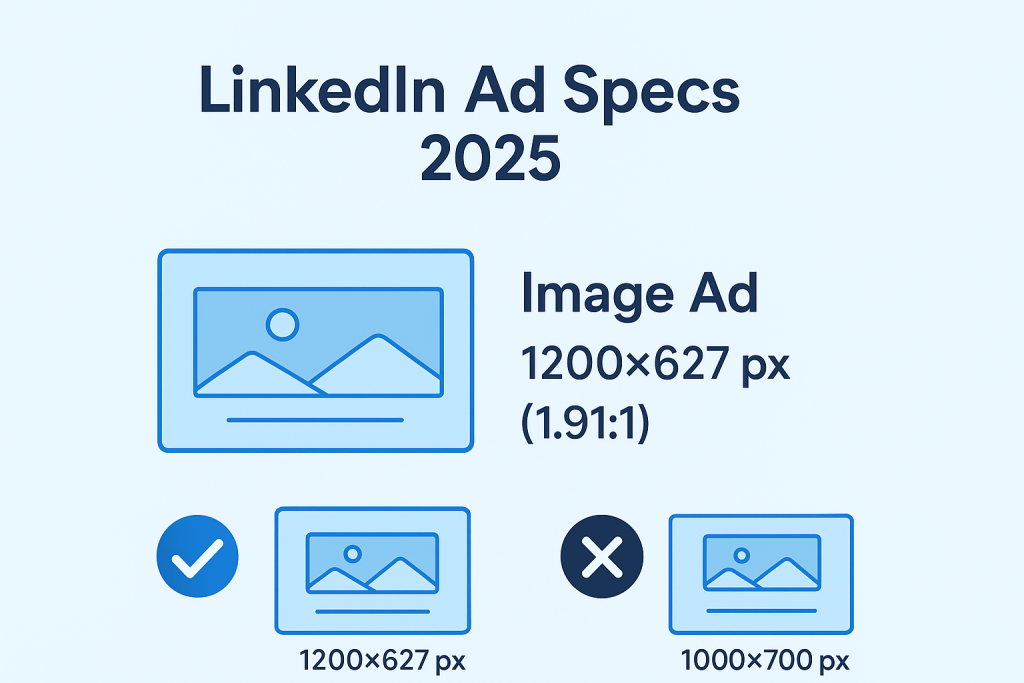
Carousel Ads Specs
| Element | Specification (2025) |
| Card Image Size | 1080 x 1080 px |
| Aspect Ratio | 1:1 |
| File Formats | JPG, PNG |
| File Size Limit (per card) | 10 MB |
| Number of Cards | 2–10 |
| Headline Limit | 45 characters per card |
| Introductory Text | Up to 150 characters |
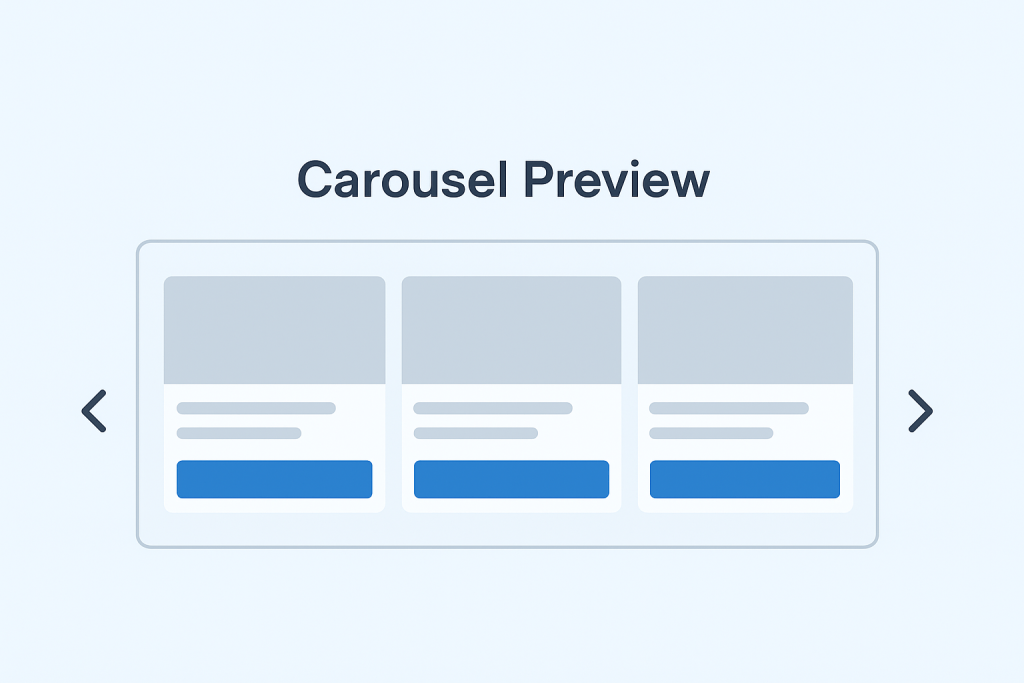
Video Ads Specs
| Element | Specification (2025) |
| File Formats | MP4 |
| File Size Limit | 200 MB |
| Video Length | 3 seconds – 30 minutes |
| Recommended Length | 15 seconds or less |
| Aspect Ratios | 1:1 (square), 16:9 (landscape), 9:16 (vertical) |
| Resolution | Minimum 360p, Maximum 1080p |
| Captions/Subtitles | Supported (SRT format recommended) |
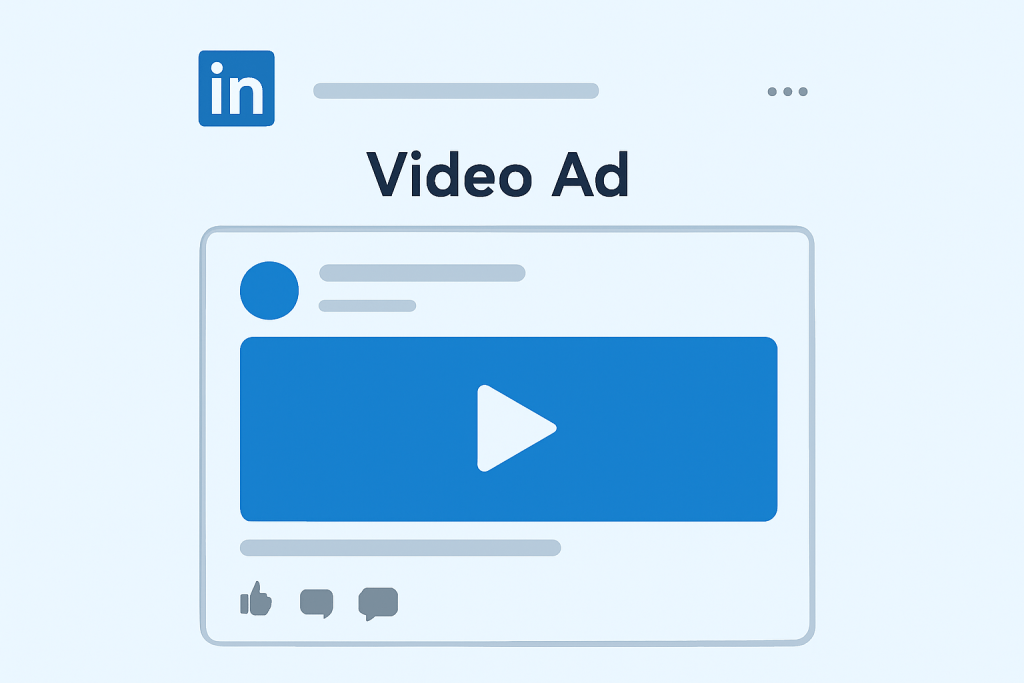
Document Ads Specs
| Element | Specification (2025) |
| Accepted File Formats | PDF, DOC, PPT, DOCX |
| File Size Limit | 100 MB |
| Page Limit | Up to 300 pages |
| Cover Image Size | 1200 x 627 px |
| CTA Options | Download, Learn More |
Message Ads (InMail) Specs
| Element | Specification (2025) |
| Subject Line Limit | 60 characters |
| Message Text Limit | 1500 characters |
| CTA Button Text | 20 characters max |
| Supported Links | One CTA button per message |
| Image Banner Size | 300 x 250 px (optional) |
Conversation Ads Specs
| Element | Specification (2025) |
| Message Text Limit | 500 characters per message |
| CTA Buttons Allowed | Up to 5 per message |
| Media Support | Images and GIFs supported |
| Banner Image Size | 300 x 250 px |
| File Size Limit | 2 MB |
Event Ads Specs
| Element | Specification (2025) |
| Event Logo Size | 300 x 300 px |
| Event Image Size | 1200 x 628 px |
| Event Title Limit | 75 characters |
| Event Description Limit | 600 characters |
| CTA Options | Register, Learn More |
Lead Gen Forms Specs
| Element | Specification (2025) |
| Form Headline Limit | 60 characters |
| Form Description Limit | 160 characters |
| Custom Questions | Up to 3 (optional) |
| Character Limit (Questions) | 100 characters each |
| CTA Button Text | Up to 20 characters |
| Field Types Supported | Name, Email, Job Title, Company, Phone Number |
Best Practices for LinkedIn Ads in 2025
Following the correct LinkedIn Ads Specs 2025 is just the first step. To maximize performance, marketers need to optimize creatives, copy, and targeting. Here’s a checklist of best practices to improve CTR, engagement, and conversions:
Creative & Design Best Practices
- Use the recommended LinkedIn image sizes 2025 (e.g., 1200×627 px for single image ads, 1080×1080 px for carousel ads).
- Stick to video specs like 15–30 seconds for higher engagement while respecting LinkedIn’s aspect ratio and resolution guidelines.
- Ensure ads are mobile-friendly, since most users access LinkedIn on mobile devices.
- Keep logos and key visuals within the safe zone of the image to avoid cropping.
Copy & Messaging Best Practices
- Write clear and concise headlines (under 70 characters) to stay within LinkedIn’s character limits.
- Use action-oriented CTAs such as “Register,” “Download,” or “Learn More” for higher CTR.
- Personalize Message Ads and Conversation Ads with tailored subject lines and conversational tone.
- Highlight value-driven benefits instead of just features to boost engagement.
Targeting & Optimization Best Practices
- Leverage LinkedIn Lead Gen Forms with customized questions to collect high-quality B2B leads.
- Test different LinkedIn ad formats (carousel, video, document) to identify what resonates with your audience.
- Monitor ad performance and adjust creative requirements like image size, copy length, or video duration.
- Avoid common LinkedIn ad mistakes such as oversized files, ignored character counts, or mismatched formats.
Engagement & CTR Boosting Tips
- Use carousel ads to share a series of images that tell a story.
- Add subtitles to your video ads to make them more accessible and engaging.
- Incorporate document ads for in-depth content like case studies or whitepapers.
- Optimize event ads to drive registrations for webinars, conferences, and live sessions.
Common Mistakes to Avoid

1. Ignoring Image and Video Specifications
One of the biggest mistakes is neglecting the LinkedIn Ads Specs 2025 for visuals. Using the wrong image dimensions, aspect ratios, or oversized files can cause ads to appear blurry, cropped, or even rejected by LinkedIn.
2. Overusing Text and Exceeding Character Limits
Many advertisers write headlines and descriptions that go beyond LinkedIn’s limits. Long text often gets cut off, making ads less effective. To improve readability, keep headlines short and ensure message ads and conversation ads follow character restrictions.
3. Poor Creative Optimization
Failing to optimize creative assets lowers engagement. Skipping subtitles on video ads, ignoring mobile-friendly design, or using generic stock images instead of branded visuals can reduce CTR and overall ad performance.
4. Weak CTA and Limited Format Testing
Another mistake is using weak or generic CTAs such as “Click Here.” Strong action-based CTAs like “Register Now” or “Download Free Guide” perform much better. Also, relying on only one format (like single image ads) instead of testing carousel, video, and document ads can limit campaign reach.
5. Not Staying Updated with LinkedIn Guidelines
Finally, many businesses rely on outdated LinkedIn advertising specifications. The 2025 updates include new dimensions, file sizes, and creative requirements. Ignoring these changes can lead to poor ad delivery and wasted budget.
Why Staying Updated on LinkedIn Ads Specs Matters in 2025
1. Ignoring Updated Image and Video Specs
One of the most common mistakes advertisers make is not following the LinkedIn Ads Specs 2025 for images and videos. Using incorrect dimensions, aspect ratios, or large file sizes can cause ads to appear blurry, cropped, or fail to display properly across devices.
2. Overlooking Character Limits in Ad Copy
Exceeding headline or description character limits reduces readability and makes ads less effective. Long text often gets cut off, especially on mobile. Advertisers should keep headlines short and impactful while ensuring message ads and conversation ads stay within LinkedIn’s guidelines.
3. Skipping Creative Optimization
Poor creative choices directly impact engagement. Neglecting to add subtitles to video ads, ignoring mobile-friendly design, or relying on generic visuals instead of branded images weakens campaign performance and lowers CTR.
4. Using Weak CTAs and Limited Ad Formats
Many businesses fail to test strong, action-driven CTAs such as “Register Now” or “Download Free Guide.” Using vague CTAs decreases conversions. Similarly, relying only on single image ads instead of experimenting with carousel ads, video ads, or document ads limits campaign potential.
5. Not Adapting to LinkedIn’s Latest Guidelines
A major mistake is relying on outdated ad specifications. LinkedIn regularly updates its advertising requirements, and the 2025 version includes new image dimensions, video lengths, and file size rules. Ignoring these updates can hurt ad performance and waste budget.
Conclusion
The LinkedIn Ads Specs 2025 are essential for businesses and marketers who want to run professional, optimized, and high-performing campaigns. By following the correct image dimensions, video requirements, file size limits, and character counts, advertisers can ensure their ads display properly across both desktop and mobile devices.
Staying updated with the latest LinkedIn advertising specifications is not just a technical requirement—it directly affects campaign performance, CTR, engagement, and ROI. Whether you are running single image ads, carousel ads, video ads, document ads, or lead gen forms, compliance with the 2025 guidelines improves user experience and strengthens your B2B marketing strategy.
If you want expert help in setting up, optimizing, and scaling your LinkedIn campaigns, Digital UpTech can guide you with the right strategy and execution. Contact us today to maximize your LinkedIn advertising ROI and stay ahead of the competition.
FAQs
1. What are the updated LinkedIn image ad sizes for 2025?
The recommended size for LinkedIn single image ads in 2025 is 1200 x 627 px with a 1.91:1 aspect ratio. For carousel ads, each card should be 1080 x 1080 px in JPG or PNG format.
2. How long can LinkedIn video ads be in 2025?
According to the LinkedIn Ads Specs 2025, video ads can range from 3 seconds to 30 minutes, but the recommended length is 15 seconds or less for higher engagement.
3. What is the file size limit for LinkedIn document ads in 2025?
Document ads support formats like PDF, PPT, and DOCX with a maximum file size of 100 MB and up to 300 pages, making them ideal for sharing in-depth resources.
4. Are there new LinkedIn ad formats in 2025?
In 2025, LinkedIn continues to support popular formats such as single image ads, carousel ads, video ads, document ads, message ads, conversation ads, event ads, and lead gen forms, with improved specs for better mobile optimization.
5. What is the best aspect ratio for LinkedIn ads in 2025?
The best aspect ratios depend on format: 1.91:1 for single image ads, 1:1 for carousel ads, and 16:9 or 9:16 for video ads. Following the recommended ratios ensures proper display across devices.
6. How do I optimize LinkedIn ads for better performance?
To optimize campaigns, follow the LinkedIn advertising specifications, keep text concise, use subtitles for video ads, design mobile-friendly creatives, and test different ad formats like carousel, video, and document ads.
7. What are common mistakes to avoid in LinkedIn advertising 2025?
Common mistakes include ignoring updated image and video specs, exceeding character limits, using weak CTAs, and relying on outdated formats. Staying aligned with the LinkedIn Ads Specs 2025 helps avoid these errors.
HOW TO GROW INSTAGRAM PAGE ORGANICALLY
If your goal is to grow Instagram page organically, the first thing you should know is that it can feel like a daunting task. The platform has changed significantly over the past eight years, adding new features like stories, reels, and broadcast channels. What started as a picture-sharing app has now become a fast-changing digital landscape with over 1.4 billion users. It’s not surprising that both individuals and businesses face increasing competition while trying to attract attention and build a brand presence. Some even think of trying to buy followers, but from experience, that’s not worth it.
Over time, I learned that the real way to increase growth is by focusing on real engagement and smart strategies. When I began studying how algorithms shift and how trends are ever-changing, I noticed it was tricky but not impossible. Through consistent content creation, sharing posts, and getting people to follow naturally, I managed to boost my results. Using a trustworthy company like My Social Following may help in the initial stages, but the stronger results come from creating authentic connection with your audience.
I also discovered that small hacks can really jumpstart growth. By using effective tips, testing different posts, and focusing on engagement through reels and stories, I was able to connect with influencers, businesses, and people in my niche. Yes, it takes consistent work, time, and sometimes feels like a “mission impossible,” but when you commit to studying, working, and sharing tips, the results in 2025 can be remarkable. You’ll find your audience gaining, your following increasing, and your account turning into a powerhouse presence.

What Does Organic Growth on Instagram Mean?
Definition of Organic Growth
Organic growth on Instagram refers to increasing your followers, audience, and brand visibility without purchasing fake followers or relying heavily on paid advertisements. It’s about using real strategies like consistent content creation, sharing posts, and building engagement through stories, reels, and authentic interactions. Instead of chasing shortcuts, you focus on gaining genuine followers who are truly interested in your platform. Over time, this approach helps you increase growth naturally and makes your account more trustworthy in the eyes of both users and algorithms.
Difference Between Organic vs Paid Growth
| Aspect | Organic Growth | Paid Growth |
| Definition | Building followers, engagement, and brand presence through real strategies, without ads. | Using ads or services to quickly boost numbers and attract attention. |
| Cost | Completely free, only requires time, work, and consistent content creation. | Requires a budget for ads or paid campaigns; not cost-free. |
| Trust & Authenticity | Builds trust with your audience because followers are real and genuinely interested. | May lack authenticity since some followers could be inactive or not genuinely engaged. |
| Sustainability | Long-term and stable, growth continues even without constant spending. | Short-term; growth usually slows down once ad spend stops. |
| Effort Needed | Takes studying, adjusting to ever-changing algorithms, and consistent sharing posts and reels. | Faster results with less personal effort, but requires continuous financial investment. |
| Competition Impact | Helps stand out despite increasing competition by focusing on engagement. | Can temporarily overcome competition but not always sustainable. |
| Best For | Individuals, businesses, and influencers who want lasting results and a strong brand presence. | Brands that need quick visibility, short-term campaigns, or have a large budget. |
Benefits of Organic Growth
The benefits of organic growth are massive. First, it creates trust between you and your audience because people know your followers are real. Second, it builds a long-term brand presence that isn’t dependent on ads or a company budget. Third, it’s completely free, which makes it perfect for businesses, influencers, or individuals starting out with limited resources. By focusing on effective strategies, using small hacks to jumpstart your journey, and being consistent with sharing tips through posts and reels, you can transform your account into a powerhouse in 2025. Organic growth not only helps you connect with the right people but also ensures your growth is sustainable and valuable for years to come.
Optimize Your Instagram Profile
When I talk about optimizing your Instagram profile, the first thing I always look at is the username. I’ve seen so many accounts try to accumulate followers without asking the right questions first. This isn’t about the endless accumulation of posts; it’s about how you reach the right people. If your username is weak, it can be amended with a quick fix. Make it concise, relevant, and true to your brand. These small things matter because your profile should cover exactly who you are. Everything you do must be based on clarity, and the tone you use should be snappy, easy to reviewed, and always ready to be updated when needed.
Now, let’s talk about posting and engaging content. Every post you share reflects your personal style and identity. Each action you take — from the moment you click publish to how you share information — influences how people see you. You’re probably wondering what this really mean, but the truth is: growth is made of a variety of details. Your bio matters, your links matter, and even the times you post matter. Keep your text short, avoid what isn’t necessary, and always make it complete and correct. A strong brand looks clear and stays consistent by creating content that gives your audience a reason to follow.
Your page is your home on Instagram. It should do more than just exist — it should do the job of telling your audience exactly what you offer. That’s why I always recommend an amended, relevant, and reviewed bio. Keep it concise, use a snappy description, and don’t forget to add links to your website. If it’s correct and complete, your profile becomes a natural extension of your brand. Remember, Instagram is not about being complicated; it’s about using small tweaks — like answering the right questions — to create a profile that your audience actually enjoys.
I always think of business growth on Instagram as an ongoing rhythm. At different times, you need to click into action, keep posting consistently, and reach the right people with a strong message. Keep creating an authentic bio, updating your information, and mixing in a variety of formats. A short description might mean more attention than a long one. The action you should take is simple: keep your profile reviewed, stay relevant, always be updated, and make it complete. That’s how you truly optimize and grow.

Key Points to Optimize:
- Use a relevant, amended, concise username.
- Write a snappy, short bio with links to your website.
- Keep your profile clear, correct, and complete for your audience.
- Focus on posting engaging content at the right times.
- Regularly get your profile reviewed, updated, and amended to fit your brand.
Create High-Quality & Valuable Content
Creating high-quality and valuable content is the foundation of organic growth on Instagram. A feature account or gallery with a laser-focused niche can attract a community-driven audience and huge followings. By consistently creating content aimed at being featured, your Instagram page can gain a significant boost in organic traffic. Many favourites, like @earthpix, highlight fantastic imagery from wildlife and nature. Research your industry, analyse the types of content these accounts feature, and replicate the best strategies using appropriate hashtags to ensure your account achieves better Instagram growth.
Ensuring each post brings variety is critical for audience engagement. You can utilise Carousels to display images and videos consecutively, which is best for telling a cohesive story. Reels represent one of the best ways to expand reach with short-form video on Instagram. GIFs are great for expressing emotions, demonstrating reaction, and adding a killer caption that resonates with followers. Stories let you show current updates, share a reel or link to relevant content, and utilise highlights to ensure stories remain visible past the 24-hour mark. Images are still a classic option to share a created poster or picture your audience can relate to. All of these methods build engagement, grow your followers, and drive consistent traffic to your page.
To stand unique and ensure long-term organic growth, variety and creativity matter most. Partnering with a professional production company like Blare Media can be a game-changer. They have helped brands explore and implement fresh, high-quality video styles that attract followers, expand organic traffic, and support Instagram page growth over time. Combining unique visuals, creative captions, and consistent posting not only increases audience engagement but also positions your account as a trusted source of valuable content in your niche.
Key Actions to Create High-Quality & Valuable Content for Instagram Growth:
- Feature account strategies: replicate niche galleries, research industry, and use relevant hashtags.
- Utilise Carousels: display images and videos consecutively to tell a cohesive story.
- Create Reels: expand reach with engaging short-form video content on Instagram.
- Add GIFs: great for expressing emotions, demonstrating reaction, and creating a killer caption.
- Share Stories: show current updates, highlight reels, links, and ensure stories remain past the 24-hour mark.
- Use Images: share created posters and pictures your audience can relate to.
- Partner with professionals: Blare Media and others helped brands implement fresh, high-quality styles.
- Explore, implement, and post consistently to drive organic growth, increase followers, and achieve better Instagram page performance
Use Hashtags and Keywords Wisely
Consistency in hashtag research on Instagram is important, and understanding your audience is the first step. Typing keywords in the search bar shows how many posts are linked to a hashtag. This tactic can Increase Followers and help your page Grow Organically. For example, a forest walking club can use hashtags to reach walkers with precision. Using #nature, which has 805M people posting, shows how powerful a niche can be when paired with the right strategy.
Choosing the right hashtag matters. A targeted keyword like #forestwalks with 250k posts allows your post to stick longer at the top. In contrast, a hashtag with millions of posts can get buried quickly. That’s why optimising and using hashtags wisely makes your captions stronger. Aim for 3-5 hashtags in every post to keep them balanced, not cluttered or spammy. When done right, hashtags connect your content with people who actively search and engage.
- Consistency improves hashtag research on Instagram
- Typing keywords in the search bar helps find the right posts
- Tactic works to Increase Followers and Grow Organically
- Forest walking club can reach walkers with hashtags
- A post can stick longer in a smaller niche
- Contrast between buried posts and optimised hashtags
- Aim for 3-5 hashtags in captions to avoid cluttered or spammy looks
Consistency is Key
Consistency is vital for building organic followers on Instagram. HootSuite recommends posting at least three times a week minimum with varied content such as reels, carousels, and static posts. Doing this increases the chances of showing up on the Explore feed, being mentioned by another account, and appearing at the top of search results for keywords you commonly use.
Staying consistent also signals the Instagram algorithm that your content is active, helping improve engagement, growth, and brand visibility. Posting consistently helps build trust with your audience and keeps your content relevant. A solid content strategy with proper scheduling and time management makes it easier to deliver fresh posts, maintain audience attention, and strengthen long-term organic results.
Engage With Your Audience
Creating content is a key area, but engaging with your audience is essential. People love to feel listened to, and replying to Dave with a comment saying something amazing or dealing with Karen and her snarky reply can show your audience that you hear them. Outside of normal comments on posts, you can reshare a funny reel or a relevant story. You can also share someone’s post that tagged you, which adds more connection.
A lot of replies can be turned into a short reel by laughing and reacting, adding more authenticity to your brand. Audiences love to follow people and brands who engage with them. Consistent engaging shows real value, helps build trust, and keeps your community active.
Engagement also boosts visibility on Instagram’s algorithm, making your posts appear more often in feeds and Explore pages. Responding quickly to messages, using interactive stickers in Stories, and starting polls are great ways to spark conversations. Genuine interactions help increase retention, improve loyalty, and drive long-term organic growth.
Leverage Instagram Stories & Reels
Highlights help to keep content in order and looking sleek. For example, you can use stories by showing a specific product to followers and people. When you give a nice cover image and add a title with the name of the product, it builds trust and keeps your page professional from the first time visitors arrive. This method also ensures brand consistency and makes your profile stand out on Instagram.
Stories and reels provide constant access to engaging updates, making them readily available to view anytime. Reels in particular are powerful for reach, engagement, and growing visibility on the Explore page. By creating short videos, adding trending audio, and using creative visuals, you can increase organic followers and boost audience interaction. Combining highlights, reels, and stories gives your audience authentic reasons to connect with your brand and return for fresh content.
Cross-Promote Your Content
It is simple to cross-promote content across social media channels. You can post reels on Facebook or TikTok and also show the same content on Instagram. This tactic helps the audience discover your brand on multiple platforms and increases engagement, reach, and visibility. By sharing consistently, you create more opportunities to grow followers organically.
Cross-promotion will help bring new audiences to Instagram and improve traffic. Sharing content on different social media channels builds trust and community while supporting long-term growth. When you post reels, show highlights, and share them strategically, you not only engage your existing audience but also attract new followers who are interested in your niche. This strategy makes your brand stand out and drives consistent organic growth.
Track, Analyze & Improve
Analytics help you understand if your content is successful. The view of analytics can vary depending on your objectives, but a good way to follow progress is to monitor watch time on Reels and video. Engagement rate, followers, and profile visits also matter when you track goals. These insights provide data-driven feedback to optimize performance and reach.
Using these metrics, you can amend and tweak strategies to continue gaining traffic, improving growth, and increasing followers on your page. Looking at trends, reviewing audience behavior, and checking a blog with detailed metrics on Instagram in 2025 acts as a guide for improvement. Analytics not only help track performance but also support long-term optimization and engagement success.
FIND THE RIGHT TIME TO POST
Posting consistent and compelling content is essential, but it’s pointless if you’re not hitting the correct times when your audience is online. Knowing when your audience is active can feel tricky. You might think you know, but that’s a lie. Thankfully, there are fantastic resources like HootSuite that break down the best time to post different types of content. These tools help you understand what works through trial and error, what you have found is effective, and how to optimize engagement, reach, and impressions for maximum performance.
The best time to post can vary depending on your audience. For example, a substantial USA-based audience may be active at different times than someone in the UK. Research your industry and use Instagram management tools to schedule your content at the right time. This ensures your posts reach your audience during peak active hours, improving audience interaction, visibility, and overall growth. Smart scheduling eliminates the need to wake up at 1 am every day while maximizing the impact of every post.
Quick Tips for Faster Organic Growth
- Produce high-quality content: Create posts, reels, and stories that truly connect with your audience.
- Maintain a consistent schedule: Regular posting improves engagement, reach, and visibility.
- Use hashtags strategically: Research trending and niche-specific hashtags to attract new followers.
- Cross-promote on other platforms: Share your Instagram content on Facebook, TikTok, or Twitter to drive traffic.
- Engage actively with your audience: Respond to comments, DMs, and interactions to build trust and loyalty.
- Monitor analytics regularly: Track which posts perform best and adjust your content strategy accordingly.
- Optimize your profile: Include highlights, a clear bio, and relevant links to boost audience interaction.
- Collaborate with feature accounts: Partner with niche pages to expand reach and increase followers.
- Understand Instagram’s algorithm: Leverage insights on post types, stories, and reels to maximize organic growth.
CONCLUSION
Growing your Instagram page organically takes strategy, consistency, and engagement. By creating high-quality content through posts, reels, and stories, you can attract a targeted audience while maintaining strong follower interaction. Optimizing your profile with a clear bio, highlights, and relevant links ensures your page stands out and keeps visitors engaged.
Using hashtags strategically, cross-promoting content on other social platforms, and collaborating with feature accounts helps expand your reach and drive traffic. Tracking analytics and monitoring engagement rates allows you to refine your content strategy, post at the right times, and maximize visibility. Consistency is key, and actively engaging with your audience strengthens community trust and encourages long-term loyalty.
Incorporating these tactics with a deep understanding of Instagram’s algorithm and audience behavior ensures sustainable growth. From leveraging professional video styles, creative content, and carousel posts to responding to comments and sharing relevant reels, each step contributes to boosting followers, enhancing engagement, and establishing your brand presence. By following these organic growth strategies, you can increase your followers, drive meaningful engagement, and achieve long-term success on Instagram.
FAQs
1. What does organic growth on Instagram mean?
Organic growth on Instagram is increasing followers, engagement, and reach naturally, without using paid ads. It focuses on creating valuable content, using hashtags strategically, posting consistently, and engaging with your audience.
2. How often should I post to grow my Instagram organically?
Consistency is essential. Posting at least three times a week using posts, reels, and stories ensures better engagement and keeps your audience connected.
3. How can hashtags help my Instagram growth?
Relevant and niche-specific hashtags make your posts more discoverable. Use 3–5 hashtags per post and research trending tags in your industry to attract the right followers.
4. Why is audience engagement important?
Engaging with your followers builds trust and loyalty. Replying to comments, responding to messages, and sharing user-generated content strengthens your connection and encourages ongoing interaction.
5. Should I share my Instagram content on other platforms?
Yes. Cross-promoting your Instagram posts on platforms like Facebook, TikTok, or Twitter can drive more traffic, reach new audiences, and support organic growth.
6. How do analytics help improve my Instagram growth?
Analytics show which posts perform best, the best times to post, and how your audience interacts with your content. This data helps refine your strategy for maximum engagement and follower growth.
7. Can collaborating with feature accounts boost growth?
Absolutely. Partnering with niche or feature accounts exposes your content to a wider audience, attracts relevant followers, and helps your page grow organically.
How to Track Affiliate Link in WordPress
How to track affiliate links in WordPress is a common question for bloggers and marketers who want to boost earnings. Affiliate links are unique URLs that direct your audience to a product or service. When a visitor clicks on the link and completes a purchase, you receive a commission. Tracking these links helps you understand which promotions work best and where your traffic is coming from.
Tracking affiliate links is important for more than just revenue. It helps measure click-through rates (CTR), monitor performance, and improve conversion rates. It also ensures you catch broken links early, keeping your site’s SEO strong. Without proper tracking, you risk losing potential sales and valuable insights.
What is Affiliate Link Tracking?
Affiliate marketing campaigns rely on tracking links to measure success and record actions. Visitors who click promotional links may complete purchases or sign-ups, and these marketing efforts help drive conversions across channels. An affiliate website, whether for paid campaigns or organic reach, can use different components to improve results.
To monitor traffic, tracking parameters are added to links.
These include UTM, or Urchin Tracking Module, tags, which help identify where the traffic is coming from. Sources can include blog posts, social media updates, email newsletters, and other channels. Cookies store a file on devices after a click or purchase, helping identify return visits. Conversion pixels, with code snippets, appear on a thank you or confirmation page to link clicks to sales and conversion events.
Multiple methods and combinations exist for affiliate tracking. The right option depends on your needs and the campaigns you run. This strategy helps in gaining more accurate marketing insights and improving the overall conversion rates.
Key Points:
- Marketing efforts track visitors through promotional links.
- Purchases and sign-ups show the success of affiliate campaigns.
- Cookies store a file on devices to follow returning buyers.
- Blog posts, social media updates, and email newsletters can drive clicks.
- Conversion pixels and code snippets on a thank you page record events.
- Methods and combinations help choose the best option for your needs.
Methods to Track Affiliate Links in WordPress
Tracking affiliate links in WordPress is essential for understanding visitor behavior, improving click-through rates (CTR), and increasing conversions. Whether you’re running a personal blog, a niche site, or a large affiliate marketing business, having accurate tracking lets you identify high-performing campaigns and optimize your promotional strategy.
There are three main ways to track affiliate links in WordPress:
- Using Affiliate Link Management Plugins—Best for beginners who want automation and ease of use.
- Using Google Analytics—Ideal for marketers who want deep reporting and data insights.
- Manual Tracking with Redirects—Perfect for advanced users seeking complete control over tracking.
Using Affiliate Link Management Plugins
Affiliate link management plugins combine link cloaking, click tracking, and organization into one tool. They’re user-friendly and allow you to manage hundreds of links from a single dashboard.
Popular Plugins:
Pretty Links

Pretty Links is a widely used affiliate link tracking plugin for WordPress. It allows you to turn long affiliate URLs into short, branded links that look professional and are easier for visitors to trust.
Key Features:
- Advanced Link Cloaking: Replace long affiliate URLs with a branded domain-based link. Example: yoursite.com/productname.
- Detailed Click Reports: Track the total number of clicks, the referring pages, and even the browser or device used.
- Link Grouping: This feature helps you categorize and manage your affiliate links more efficiently.
- Automatic Keyword Linking: You can assign specific keywords to your links, and the plugin will automatically convert those keywords within your content into affiliate links.
Why It’s Good for Tracking:
Pretty Links provides real-time tracking of clicks, allowing you to identify which campaigns are most effective. You can also set up expiration dates for limited-time offers, making it perfect for seasonal promotions
ThirstyAffiliates
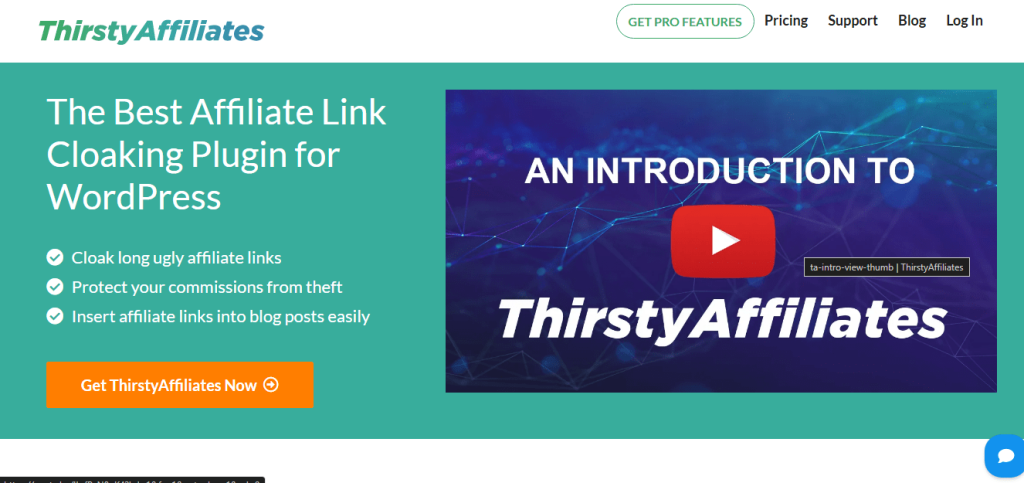
ThirstyAffiliates is designed specifically for affiliate marketers and goes beyond simple link cloaking. It’s built for organizing, inserting, and tracking affiliate links from within the WordPress editor.
Key Features:
- Category-Based Organization: Group links into categories such as “Tech Products,” “Fashion Deals,” or “Online Courses” for quick retrieval.
- Built-In Click Stats: See which links are clicked most often and from where.
- Link Shortening & Cloaking: Create clean, branded URLs that are easier to promote.
- Broken Link Checker: Automatically scans for broken affiliate links so you don’t lose commissions.
Why It’s Good for Tracking:
ThirstyAffiliates provides detailed reporting that breaks down click data by link and category. This helps identify which product niches bring in the most conversions
Lasso
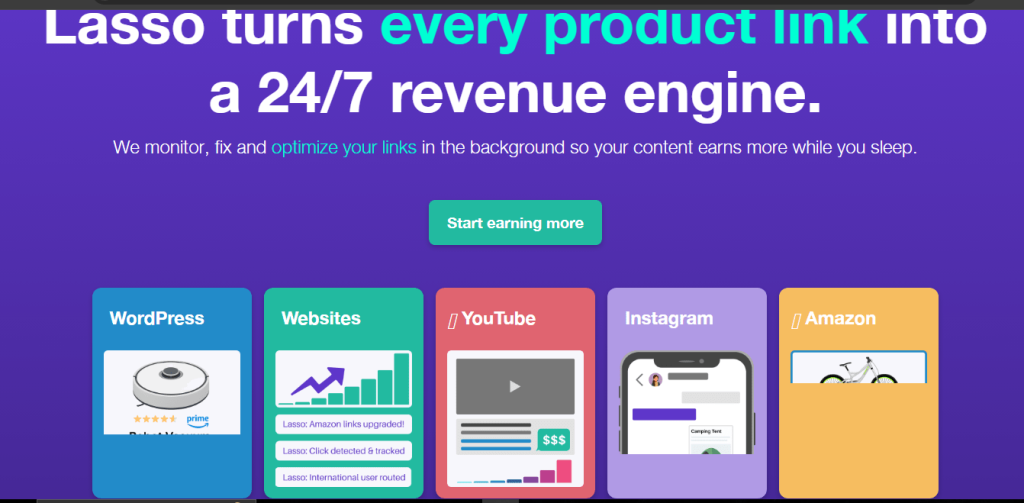
Lasso is a premium affiliate marketing plugin that focuses on both tracking and presentation. It not only helps you manage links but also creates beautiful affiliate product boxes that can improve click-through rates.
Key Features:
- Affiliate Link Cloaking & Tracking: Shortens and tracks every link you create.
- Product Display Templates: Add customizable product boxes with images, prices, and calls to action.
- Link Health Monitoring: It notifies you if an affiliate link is broken or if the product is no longer available.
- Revenue-Focused Analytics: Shows which links drive the most clicks and sales.
Why It’s Good for Tracking:
Lasso combines link tracking with conversion-focused design. By presenting affiliate products in visually appealing formats, you can attract more clicks while monitoring performance through built-in analytics.
Using Google Analytics
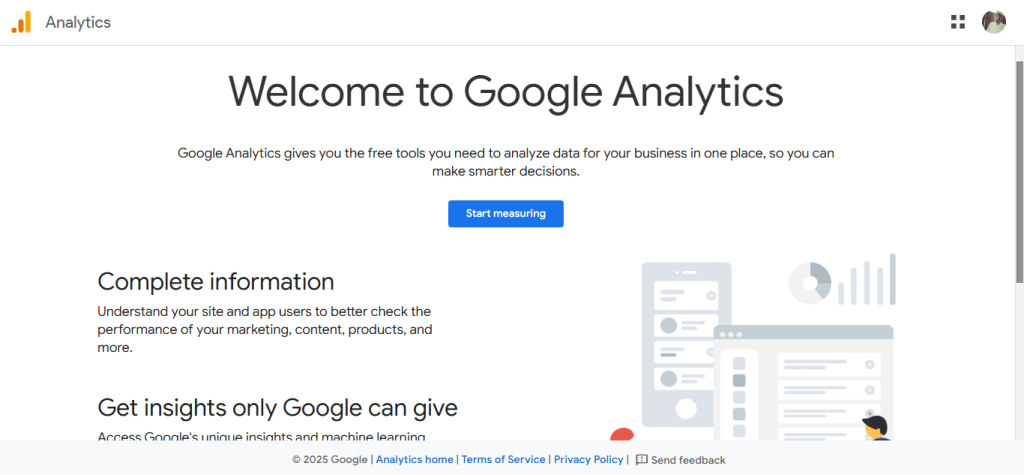
Google Analytics is a powerful and free tool that can track affiliate link clicks, monitor traffic sources, and measure conversions. Unlike some WordPress plugins, it offers a broader view of user behavior, making it ideal for marketers who want advanced tracking without relying on multiple tools.
Why Use Google Analytics for Affiliate Tracking
- Free & Reliable: No extra cost, and Google maintains the platform for accuracy.
- Comprehensive Data: Track affiliate clicks alongside overall site performance.
- Custom Event Tracking: Measure outbound link clicks specifically for your affiliate campaigns.
- Audience Insights: See which devices, locations, and user segments convert the most.
Step-by-Step Setup for Affiliate Link Event Tracking
Log in to Google Analytics
- Go to your GA4 property dashboard.
Create a Custom Event
- Navigate to Admin → Events → Create Event.
- Give it a name like affiliate_click.
- Set the condition to trigger when the click URL contains your affiliate domain (e.g., shareasale.com or amazon.com).
Mark the Event as a Conversion
- Go to Events, find your custom event, and toggle Mark as conversion.
Track in Real Time
- Use the Realtime tab in GA4 to ensure clicks are being recorded

Using Google Tag Manager for More Control
Google Tag Manager (GTM) works hand-in-hand with Google Analytics, allowing you to set up tracking without editing your site’s code.
Steps to Use GTM for Affiliate Tracking:
- Create a new click trigger for outbound links.
- Use Click URL matches to include only your affiliate domains.
- Then, attach a GA4 Event Tag to send the data to Google Analytics.
- Test your setup using GTM’s Preview Mode before publishing.
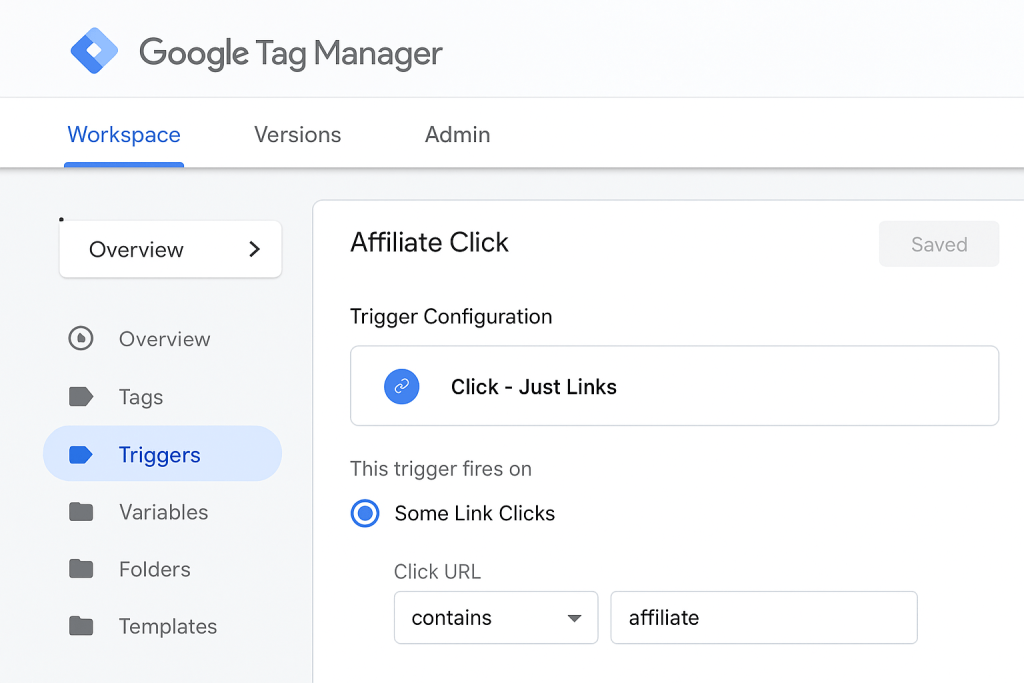
Advantages of Google Tag Manager for Affiliate Links
- No need to edit code in WordPress.
- Create advanced tracking rules for multiple affiliate programs.
- Update tracking settings instantly without a developer.
- Combine UTM parameters with event tracking for better attribution.
Manual Tracking with Redirects
Manual tracking is a flexible method for affiliate marketers who want full control over how clicks are monitored and recorded. Instead of relying on plugins or automated tools, you can create custom URLs, add tracking parameters, and manage redirects yourself. This approach is especially useful for advanced users who want highly customized tracking setups.
Using WordPress Redirection Plugins
While this is still “manual” in approach, WordPress redirection plugins allow you to create short, memorable URLs that redirect to your affiliate link.
How to Set Up a Redirect for an Affiliate Link:
- Install a redirection plugin such as Redirection or Simple 301 Redirects
- Add a source URL like yoursite.com/product-name
- Set the target URL to your actual affiliate link (e.g., https://affiliateprogram.com/product?ref=123).
- Save the redirect and test it to confirm it functions correctly.
Advantages:
- Easy to remember and share links.
- Keeps affiliate URLs hidden from direct view.
- You can update the destination URLs without having to change the link across all places.
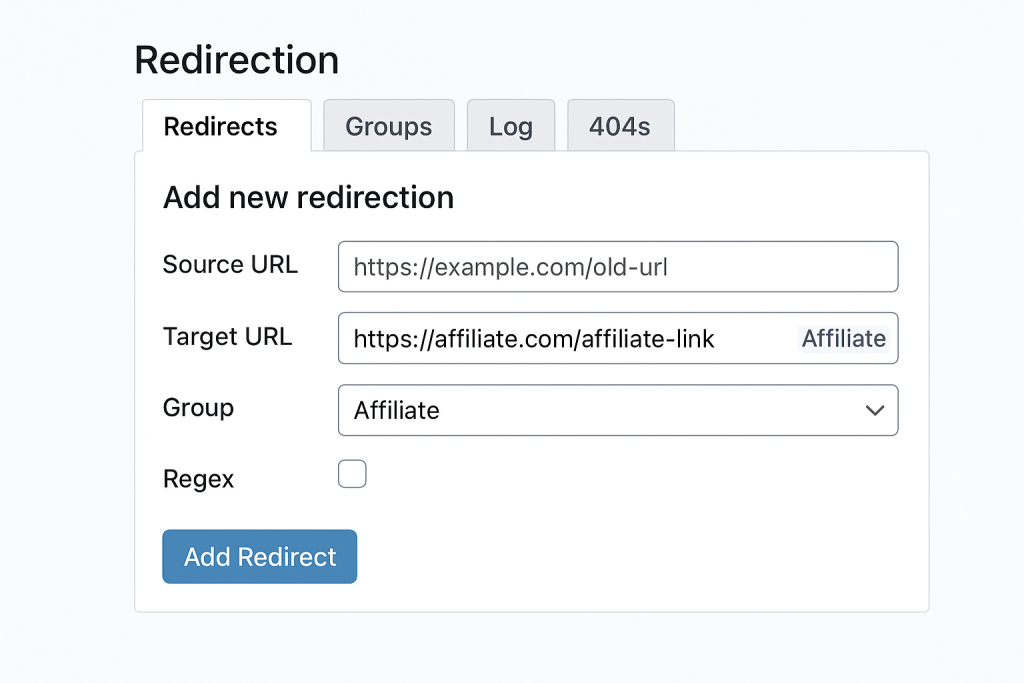
Adding Custom Tracking Parameters (UTM Tags)
UTM tags are special tracking codes you attach to your affiliate links. They tell analytics tools where traffic is coming from, which helps you measure the success of each campaign.
How to Create UTM Parameters:
- Open the Google Campaign URL Builder.
- Enter your affiliate link in the Website URL field.
- Fill in parameters:
- utm_source (e.g., blog, email, Facebook)
- utm_medium (e.g., affiliate, banner, post)
- utm_campaign (e.g., winter_promo, black_friday)
- Copy the new URL and use it in your promotions.
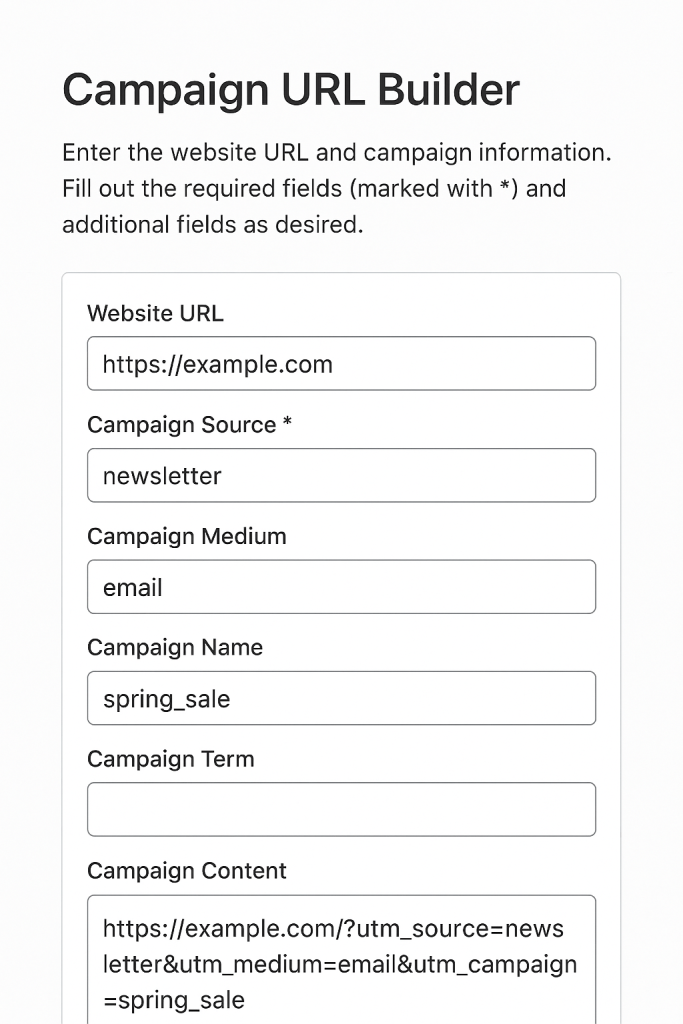
Benefits of Manual Tracking with Redirects & UTM Tags
- Full Control: Decide exactly how your links are structured and tracked
- Better Data Attribution: See exactly which posts, emails, or ads generate affiliate clicks
- Cross-Tool Tracking: UTM tags integrate with Google Analytics, Google Tag Manager, and other analytics platforms
- No Plugin Dependency: Works even if your WordPress site has minimal plugins.
Potential Drawbacks
- Requires more time to set up and manage.
- Tracking data may be spread across multiple tools.
- Mistakes in URL structure can break tracking.
Pro Tip:
Combine redirects with UTM tags for the best results. For example, your short branded link can redirect to an affiliate URL that already contains UTM parameters, allowing you to track performance while keeping links clean and professional.
Best Practices for Affiliate Link Tracking
Affiliate link tracking is essential for improving conversions and building trust with your audience. Cloaking long and messy affiliate URLs into short, branded links is one of the most effective ways to make links look professional and user-friendly. This also boosts click-through rates by making them appear more trustworthy.
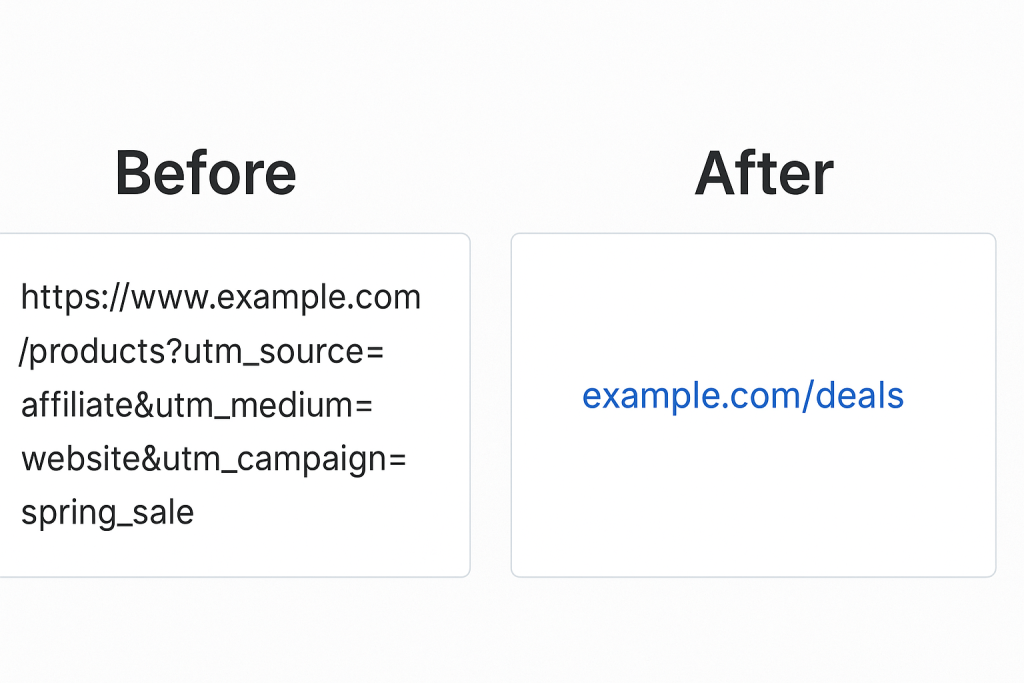
Using descriptive link slugs that include relevant keywords helps with SEO optimization and makes it clear what the link represents. Along with that, monitoring performance reports on clicks, traffic sources, and conversions allows you to measure success and adjust campaigns effectively.
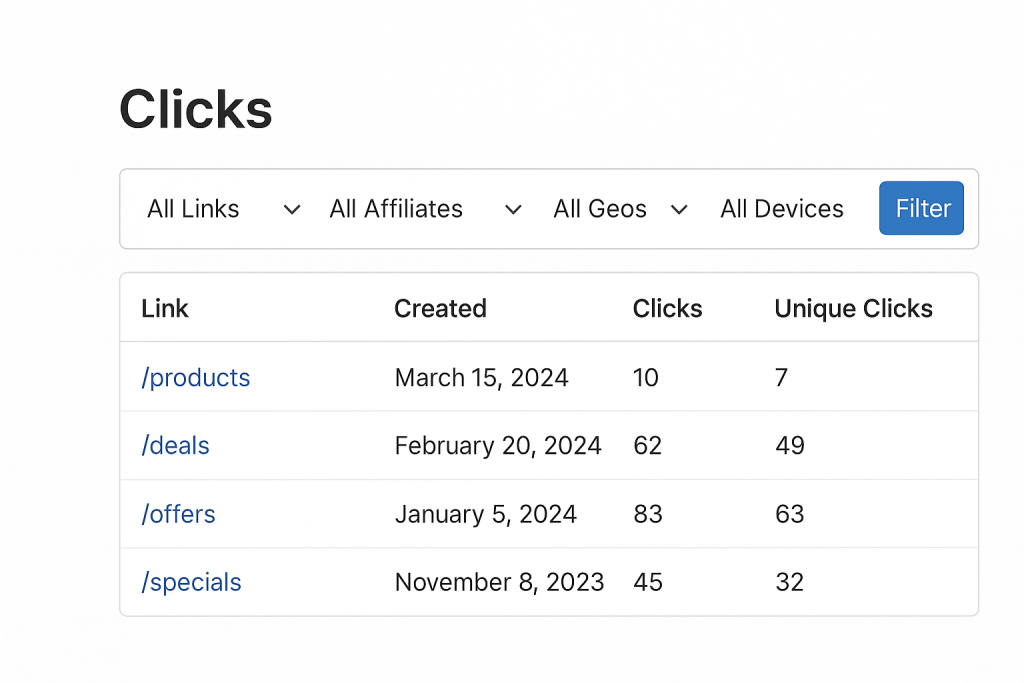
Lastly, always test your affiliate links. A broken or outdated link not only leads to lost sales but can also damage your credibility with visitors. Consistent testing ensures smooth user experience and accurate tracking.

Quick Best Practice Checklist
- Always convert long URLs into clean and branded links.
- Use descriptive slugs with keywords to improve SEO.
- Regularly review click reports, traffic sources, and conversions.
- Test affiliate links frequently to avoid broken or outdated URLs.
Common Mistakes to Avoid in Affiliate Link Tracking
| Mistake | Why It’s a Problem | How to Fix It |
| Not cloaking affiliate links | Links look spammy and reduce user trust | Use plugins like Pretty Links or ThirstyAffiliates to cloak URLs |
| Ignoring performance reports | Missed insights on clicks, conversions, and traffic sources | Regularly check plugin dashboards or Google Analytics reports |
| Using generic link slugs | Hurts SEO and makes links unclear to users | Add descriptive slugs with keywords (e.g., /best-hosting instead of /link123) |
| Not testing affiliate links | Broken or outdated links lead to lost sales and poor UX | Test links frequently to ensure they work properly |
| Overusing redirects | Slows down page speed and may harm SEO | Use clean redirects only when necessary |
Conclusion
Affiliate link tracking in WordPress is more than just monitoring clicks—it is the foundation of building a profitable affiliate marketing strategy. By using tools like Pretty Links, ThirstyAffiliates, Lasso, and Google Analytics, you can cloak long URLs, track conversions, and gain valuable insights into performance across different channels.
When you follow best practices, such as creating branded slugs, analyzing reports, and testing links regularly, you ensure accuracy and prevent common mistakes like broken links or poor SEO performance. Effective tracking not only boosts conversions but also helps you measure success and optimize your affiliate campaigns.
In short, learning how to track affiliate links in WordPress gives you better control, increases trust with your visitors, and helps grow long-term revenue from your affiliate marketing efforts.
FAQs
Q1. What is affiliate link tracking in WordPress?
Affiliate link tracking in WordPress is the process of monitoring clicks, conversions, and traffic sources on your promotional links. It helps measure the success of affiliate campaigns and improve marketing performance.
Q2. How do I track affiliate links in WordPress without coding?
You can track affiliate links in WordPress easily by using plugins like Pretty Links, ThirstyAffiliates, or Lasso. These tools provide features such as cloaking, click tracking, and performance reports—without needing any coding skills.
Q3. Can I use Google Analytics for affiliate link tracking?
Yes. By setting up event tracking in Google Analytics or using Google Tag Manager, you can monitor affiliate clicks, measure conversions, and analyze traffic channels like blog posts, social media, and email campaigns.
Q4. Why is it important to cloak affiliate links in WordPress?
Cloaking affiliate links helps make long URLs shorter, more branded, and easier for users to read. It improves trust, prevents broken links, and also supports better SEO optimization.
Q5. What are the best methods to track affiliate links in WordPress?
The most popular methods include:
- Using affiliate link management plugins (Pretty Links, ThirstyAffiliates, Lasso)
- Setting up Google Analytics and Google Tag Manager
- Adding custom UTM parameters and conversion pixels
- Manual tracking with WordPress redirection plugins
Q6. How often should I check affiliate link reports in WordPress?
It’s best to check your affiliate reports regularly—weekly or monthly. This helps you spot broken links, track conversions, measure success, and optimize your affiliate campaigns for higher revenue.
Surfer SEO vs Frase: Complete Comparison for 2025
Introduction
In the world of content optimization, having the right SEO tool can make or break your rankings. Whether you are a blogger, freelancer, or running a digital agency, tools like Surfer SEO and Frase can help you create high-quality, SEO-optimized content that ranks on Google.
Surfer SEO focuses on data-driven SEO, keyword research, and on-page optimization, while Frase excels in AI content generation and creating content briefs. Both tools offer powerful features for SEO audits, SERP analysis, and improving content performance.
In this Surfer SEO vs Frase comparison, we will look at their features, pricing, and performance so you can choose the best tool for your needs.
Overview of Surfer SEO
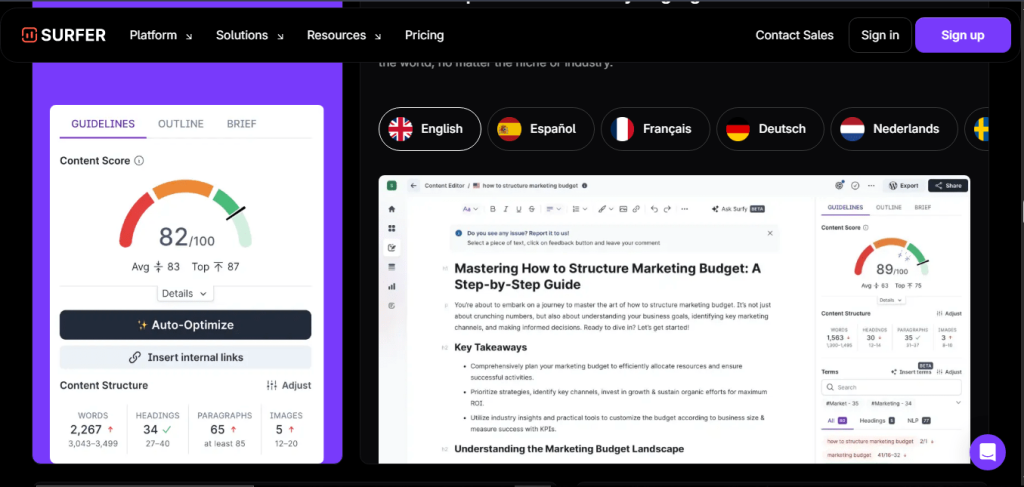
Surfer SEO is a powerful content optimization tool that helps writers, marketers, and analysts improve on-page strategies with an advanced suite of features. This artificial and intelligent platform specializes in articles and website performance, using natural language processing (NLP) to analyze the SERP for any keyword or niche. With over 20,000 users worldwide, Surfer offers relevant solutions to find new opportunities, optimize existing pages, and ensure each term, phrase, and structure meets the ideal word length for better rankings.
The Content Editor, often a favorite among beginners and professionals, provides detailed insight into top pages by showing densities, outlines, and semantic keywords. The SERP Analyzer reviews competitors, revealing what they’re doing right while exposing shortcomings in your site, speed, backlinks, or article structure. Using the Content Planner, Surfer can group keywords into topics, identify the overarching search intent, and even leverage keyword research tools similar to Ahref’s planner or SEMrush’s magic tool.
Surfer has also introduced AI writing capabilities with its assistant named Surfy. This feature allows you to generate and create optimized content, whether manual or auto-optimized, while managing credit, tabs, and settings easily. The platform offers topic discovery, anti-AI detection, and generation tools, though in lower quantities than some platforms like ChatGPT. Users can also choose to run an audit, which gives suggestions to quickly work out shortcomings, compare with a competitor, and raise your content score—but always balancing risk and quality.
From KeyClusters control options to real-time analysis, Surfer supports both lite users and large teams. The community, academy, and support behind it are amazing, making it a great choice for those who value readability, critical insights, and avoiding cutting corners on quality and time. While the cost may feel higher or even prohibitive to some, the features and strategy it offers are useful, gimmicky only in gamification style, and powerful enough to justify the price point.
Pros
- Powerful AI, writing, and content optimization capabilities.
- Content Editor, SERP Analyzer, and Content Planner provide detailed insights.
- Real-time analysis, NLP, and topic discovery improve strategy
- Strong community, academy, and support.
- Helps beginners and experts find, create, and optimize relevant articles.
Cons
- Cost can be higher and prohibitive for light users.
- Lower quantities of AI generation compared to ChatGPT.
- Some gimmicky elements, like the traffic light scoring system, may distract from critical SEO tasks.
- Over-optimisation risks impacting readability and search intent
Overview of Frase

Frase is a go-to tool for creating content briefs that help marketers, writers, and creators streamline their entire creation workflow. With powerful integration, it enables optimization through detailed keyword analyses, real-time SERP data, and multi-source research. The software offers features like Outline Builder, Templates, and AI Writer, making it a favorite for those who need impactful and comprehensive results.
Unlike a typical writer, Frase can automatically generate outlines, titles, and posts within minutes, using prompts that are based on People Also Ask, Reddit, and Quora queries. It helps find gaps in competitors’ content, suggesting fixes and refining strategies for top-ranking competitive topics. This approach provides insight into ideal word length, number of headings, topics, and questions for maximum effectiveness.
Frase also allows users to set tone, voice, and custom presets to keep brand tones consistent. Its team support, onboarding, and help center make it easier for tech brands, including WordPress, to execute long-form articles, short-form email, and social campaigns. From boosting marketing spectrum coverage to rewriting and settings control, it excels in delivering quality while avoiding writer’s block.
Even though some platforms like Surfer or SurferSEO offer similar tools, Frase stands out with its versatile wealth of information and assistant features that automate standard processes. Whether you want to write entire articles or generate punchy, competitive posts, Frase makes it possible with top-notch execution.
Pros of Frase
- Impressive AI-powered content creation and outline building
- Detailed SERP analysis with real-time data
- Helps find and fix competitor gaps
- Custom brand tones and preset settings
- Integration with multi-source research for comprehensive coverage
Cons of Frase
- Glitchy access at times and may close unexpectedly
- The basic plan can feel limited compared to the pricing.
- Occasional scary AI suggestions that need manual review
- Contentellect integration may be difficult for new users
- Time waste possible if settings are not optimized
Surfer SEO vs Frase: Feature Comparison
1. Content Direction and Structure
Frase and Surfer SEO both guide content creation using a brief and outline that keep your work relevant to the target audience. These tools focus on analyzing competitors, tracking rank positions in SERPs, and checking top-ranking pages for the right keywords and topics. You’ll get questions, heading ideas, and recommendations on length, density, and images. With built-in guidelines and sections, it’s easy to share documents with writers, sign in to the editor, and connect with Google Docs for smooth collaboration.
2. Research and Insight Tools
Frase excels in topic clusters, headers, and people-also-ask SERP research, while also pulling insights from Quora, Reddit, and statistics to form a comprehensive plan for agencies. It supports keyword-based content creation, allowing you to analyze and generate ideas with extra detail and granularity.
3. AI Writing and Optimization
With AI Writer, Frase can rewrite sentences, craft a blog post introduction, suggest a title, turn bullet points into answers, or adapt product and service features into benefits. Surfer SEO’s Outline Builder offers AI-generated suggestions in a tab format, a brief for notes, and a score tracker up to 100 with percentage and average benchmarks. Its suggested terms and topic densities ensure your content is highly optimized.
4. Pricing and Final Thoughts
For those who need follow-up drafts, how-to guides, and usable outlines, both platforms deliver, but in different ways. Surfer SEO focuses on main structure, starting points, and competing analyzed results, while Frase offers more flexibility and faster creation. Both aim to stay plagiarism-free, integrate with Jasper, and cover diverse features, though some plans may be pricey for heavy use.
Performance & Accuracy
- Both Surfer SEO and Frase focus on data-driven comparison to deliver accurate and reliable results for content optimization.
- Keyword suggestions are generated through deep SERP analysis, ensuring only the most relevant search terms are targeted.
- Detailed content scores help track alignment with SEO best practices, monitor topic coverage, and refine the structure for better rankings.
- SEO audit insights highlight optimization gaps, uncover missed keywords, and suggest fixes to outperform competitors.
- Real-time updates in Surfer SEO allow instant adjustments to content based on performance metrics.
- Frase provides a smooth interface and automated research tools to quickly gather keyword suggestions and competitor insights.
- Both platforms operate with high speed and reliability, minimizing lag and ensuring a seamless workflow.
- Marketers, agencies, and content creators can make informed decisions without delays, boosting productivity and maintaining accuracy.
Pricing & Value for Money
| User Type | Best Choice | Pricing Approach | Key Features Included | Performance & Accuracy | Why It’s Cost-Effective |
| Freelancers | Frase | Value-driven, affordable | AI-generated briefs, keyword-based outlines, automated content creation, content optimisation | Fast AI generation, decent keyword suggestions, strong outline builder | Saves time with automation, ideal for smaller budgets |
| Agencies | Surfer SEO | Premium, precision-oriented | SERP analysis, competitor insights, keyword density tracking, content score system | Highly accurate keyword research, data-rich SEO audits, detailed competitor analysis | Handles multiple client projects efficiently, improves ranking potential |
| Enterprises | Depends on Needs | Flexible high-tier options | Surfer: Large-scale audits & optimisation; Frase: Unlimited AI generation & streamlined workflows | Surfer excels in precision; Frase excels in speed & workflow automation | Choice depends on focus—precision (Surfer) or speed (Frase) |
Use Cases: Who Should Use Which Tool
Surfer SEO – Best for Data-Driven SEO
Surfer SEO is perfect for data-focused content optimization. It suits agencies, enterprises, and SEO specialists who need detailed SERP analysis, keyword density tracking, and competitor comparisons. With content scoring, keyword length guidance, and precise recommendations, it ensures top-ranking accuracy for large-scale projects.
Surfer SEO – Ideal for Competitive Niches
If your goal is to outrank competitors in search results, Surfer’s granular insights and audit features make it a reliable choice. It’s especially powerful for competitive markets where even small SEO improvements can drive significant traffic.
Frase—Best for AI-Driven Content Creation
Frase is the go-to tool for freelancers, content creators, and marketers who need to generate briefs and drafts quickly. Its AI-generated outlines, People Also Ask integration, and idea suggestions help create content that’s SEO-aligned and engaging.
Frase—Perfect for High-Volume Content Production
For teams needing multiple posts in less time, Frase’s AI writing templates and automation tools make it possible to produce high-quality content within minutes, without sacrificing relevance or search optimization.
Pros & Cons Summary
| Tool | Pros | Cons |
| Surfer SEO | – Detailed SERP analysis for top-ranking accuracy – Strong keyword density tracking- Comprehensive content scoring system – Ideal for competitive niches – Advanced audit features for optimisation | – Higher pricing compared to alternatives – AI content generation is limited – Steeper learning curve for beginners |
| Frase | – Excellent AI-generated briefs & outlines – Quick topic gap analysis – People Also Ask, Quora, Reddit integration – Fast and easy for high-volume content – Budget-friendly for freelancers | – Occasional glitches in the editor – Less granular SERP analysis than Surfer – AI content may require manual refinement |
Conclusion
In conclusion, both Surfer SEO and Frase offer unique strengths for marketers, agencies, freelancers, and content creators aiming to dominate the SERPs. Surfer SEO stands out for its data-driven optimization, delivering precise keyword density tracking, content scores, and comprehensive SEO audit insights. It is ideal for those who need granular competitor analysis, detailed recommendations, and the ability to fine-tune content for top-ranking positions.
On the other hand, Frase excels in AI-powered content briefs and outlines, helping you create high-quality, SEO-optimized articles in less time. With integrations like People Also Ask, Quora, and Reddit, it streamlines topic research and enables you to generate long-form and short-form content efficiently.
Ultimately, the choice depends on your needs: if you require precision, advanced analytics, and a competitive edge, Surfer SEO is the right fit. If your focus is speed, creativity, and scalable content production, Frase offers excellent value—especially for those seeking AI-driven content creation without compromising on SEO optimization.
FAQs
1. What is the main difference between Surfer SEO and Frase?
Surfer SEO is a data-driven content optimization tool focusing on keyword density, content scores, and competitor analysis. Frase, on the other hand, is an AI-powered platform that creates content briefs, outlines, and topic ideas quickly, using integrations like People Also Ask, Quora, and Reddit.
2. Which tool is better for keyword research?
Surfer SEO excels in granular keyword research by analyzing top-ranking pages in the SERPs and providing detailed recommendations. Frase also offers keyword suggestions, but its strength lies more in content creation and idea generation.
3. Can Frase replace Surfer SEO for SEO audits?
Not entirely. While Frase offers real-time SERP analysis and competitor gap insights, Surfer SEO provides in-depth SEO audits, keyword densities, and score tracking that are more advanced for full-scale optimization.
4. Which is more cost-effective for freelancers and agencies?
Freelancers may find Frase more affordable due to its AI content generation features included in lower plans. Agencies handling large-scale SEO projects may find Surfer SEO’s analytics and audit tools worth the higher investment.
5. Do these tools integrate with Google Docs or other editors?
Yes, both Surfer SEO and Frase work with Google Docs.
This lets writers create and optimize content directly within the tool, making it easier for teams, editors, and agencies to manage their workflows.
What is a Content Cluster? A Complete Guide for SEO Success
When I first started in digital marketing, my focus was just getting a website to appear on search engines like Google. But I soon learned that authority online isn’t just about writing random blogs—it’s about creating content in clusters with a clear strategy. This turns your site into a trusted resource for specific topics. From my own blog work, I’ve seen the benefits in SEO when you follow the algorithm updates that big companies, websites, and creators adapt to.
The most effective strategies use a structured approach to improve organic rankings, boost traffic, and cover each topic in a based format. By shaping your ideas as SEO’s suggest, using linking between related pages, and focusing on keyword research, you can connect your pages into valuable assets for your site.
A good article in a cluster works like a spoke in a wheel, supporting the central hub or pillar page. The engine behind this result is consistent use of the right keywords to build topical authority. I remember working with Ignite, where they explained the details of the hub-and-spoke model until I felt like an expert. From a user experience view, the flow felt natural, guiding readers easily.
WHAT IS A CONTENT CLUSTER?
A topic cluster is an SEO technique that connects a main page, called a pillar, with several related pages of content. Through smart linking like spokes on a wheel, it helps users and Google find all the information they need. Whether the subject is health, fitness, weight training, or a legal practice like conveyancing, the aim is to give a detailed overview and guide readers to supporting articles on subtopics. This approach targets a main keyword while adding keywords for smaller articles, boosting organic traffic and topical authority.
In my experience in the industry, an interconnected collection of blogs covering different angles of a specific area has real impact. A firm of property solicitors might write a long-form article about conveyancing, then add linked posts on aspects like freehold, leasehold, and searches. A hypnotherapist could start with an overview of hypnotherapy and then write about issues such as confidence, phobias, or grief. Done right, this works with engines and their algorithm—a point expert strategist Adam Collins often makes. The result is a website that feels natural to browse, much like Wikipedia, delivering clear answers and keeping visitors engaged.

Key Components of a Content Cluster
A content cluster works like a well-structured book, where the pillar is the core piece that gives an overview of a topic and provides answers to every question. This pillar content is placed at the center of your website, guiding users toward supporting articles that focus on more specific subtopics. Each cluster has a clear purpose, delivering valuable information tailored to different user intents and keeping all related content connected.
Pillar Content
The pillar page covers the topic broadly, offering concise information and acting as a guide for visitors. It touches on all keywords, phrases, and articles that matter to your business—from financial planner tips to pension advice and state salary benefits. It sets the foundation for your SEO strategy so that search engines like Google can understand your pages better.
Cluster
Cluster pages focus on supporting content that explores specific subtopics in depth. Whether it’s keyword research, long-tailed phrases, or niche articles about SIPP (Self-Invested Personal Pension), these clusters help your website target multiple results in SERPs and improve rank potential.
Internal Links
Internal links act like the plotline of your book, creating ties between pillar content and clusters. Using contextual linking ensures search engines and users can easily connect to other related content, improving experience and boosting rankings. This tight network signals to Google that your website is an authority on the topic.
Why Are Content Clusters Important for SEO?
Comprehensive Topic Coverage
Content clusters offer comprehensive information on a topic, which is important for many reasons. Search engines work to understand a website, and clusters indicate that topics and subtopics are fully addressed. They also determine contextually how your site connects to its subject.
Building Topical Authority
Clusters help build topical authority by giving the opportunity to share accurate, cohesive, and well-written content. Google sees a site as an encyclopedia on a subject when it consistently delivers this level of quality. This can tell it the hierarchy of each group of content.
Organizing Website Structure
Search engines crawl pages and follow a map of internal links to specific resources. This structure allows you to dominate keyword groups and avoid cannibalization. Closely related terms are distributed with focus, lowering the chance of overlap.
Improving Quality and User Experience
Quality is crucial in SEO, and a thorough approach that matches user intent makes writing useful. Better user experience comes when answers are relevant, linked well, and easy to navigate. This stops users from going back to results or visiting the competition.
Driving Conversions and Value
Increased conversions happen when you implement clusters effectively. Longer dwell time follows a search query, as a visitor lands on your site and moves through pages. Showing expertise, value, and a clear offer can guide users to a sales page and a conversion.
Supporting SEO Strategy and Growth
The benefits of clusters include stronger linking, improved relationships between pages, and in-depth resources that give reasons for return visits. Higher rank comes from being a trusted source of friendly and helpful content. Leads flow through a funnel when creating clusters as part of an essential SEO strategy. This helps ranking, supports learning, and keeps contact through a blog.
How to Create a Content Cluster
Creating topic clusters can be a challenging process, sometimes quick but at times tedious. The steps start when you conduct keyword research to find your core topics that can dominate specific groups. Add detail to your keywords using a tool like Ahrefs Explorer to discover popular queries and note any difficulties or traffic potential for related searches.
Identify Pillar Content
The next step is to identify your pillar content that speaks to your buyer persona or customer who is actively searching. Agencies like Amplihigher or a copywriting agency in marketing can help you turn obtuse ideas into a strong blog or website structure. Ensure it is specific but not too broad so it attracts the right audience, such as business owners or writers. Provide an example with contextual linking and different types of resources.
Use Visual Planning
When you choose a visual path, get started with services that focus on helping you build. Audit and map your current idea, then clean your assets. Every piece should be relevant, actionable, and thorough, with updated insights to improve ranking for your desired topics. You can combine similar ideas into a comprehensive plan with visuals to keep your audience engaged. Include tables, video, and graphics that are optimized for readability.
Structure for Readability
Break your content into bucket brigades, bullet points, and numbered lists with clear headers. Remove anything irrelevant or merged without purpose. Follow search algorithm standards and add valuable material for a deep dive into existing connections. Use hyperlinks where applicable and fill any gaps or missing pieces your audience is seeking. This approach will help generate qualified results and answer common questions.
Strategy and Updating
Build a strategy for updating your content to maximize value. Use a calendar for supporting chunks of content and schedule regular drips. You may also hire experts to create a conducive structure and publish articles that are pleasantly readable. Check if it performs correctly and avoid being overstated. Ensure your content can be navigated easily, is web-friendly, and can be crawled by search engines for users.
Writing and Internal Linking
Prepare a list of articles to write and plan for your chosen topics. Book some time in your work schedule to create blogs. We recommend writing without overthinking and editing later. Make drafts that are detailed and informative, ensuring every piece provides value. Maintain a consistent tone and style in line with your brand’s voice. Monitor performance, update information, and keep adding fresh content. Follow Google quality and quantity guidelines—whether word counts hit experts’ 2,000+ long-form target or 800 words to explain your main topic without readers feeling waffle.
Technical Implementation
Use a step-by-step guide to implement topical themes from seed keywords. Tools like SEMRush help you search and find ideas. Create a sitemap showing your supporting blogs to cover the entirety of the topic. Gloomaps is a free option. Add resource guides and landing pages. Over time, keep including links to new posts. Internally link between your content hub and spread authority across the site to increase authority. Use internal linking to pass link juice to important areas.
Best Practices for Content Clustering
To get the most from a content cluster, use a clear SEO strategy aligned with user intents and search engines. Focus on search intent with detailed keyword research. Include long-tailed phrases and related keywords that match what users search. This ensures pillar content and supporting articles provide answers to every question in your topic clusters. A financial planner can create a pillar on pensions and link supporting content about SIPP (Self-Invested Personal Pension), salary benefits, and pension advice.
Keep content well-structured so Google and other search engines can connect and rank it. Organize the core piece with a clear overview and divide it into subtopics or chapters with a specific purpose. Use internal links that are contextual and relevant. This linking improves rankings in SERPs and enhances the experience for users, guiding them through the plotline of your business objectives.
Update and refresh articles regularly to keep accuracy and stay competitive in engine results. Fresh, related information keeps the content cluster relevant. This helps the website remain a trusted guide for users while meeting SEO objectives.
How can I use a content marketing strategy with a cluster?
Using a marketing content strategy with a cluster involves more than just posting random blogs—it’s about building a clear, interconnected process that boosts your website visibility and helps attract and retain a clearly defined audience. By creating and distributing valuable and relevant material, you can ultimately drive profitable customer action while strengthening your topic clusters for better search engine performance.
Here’s how you can do it effectively:
- This strategy ensures your audience not only visits but stays engaged, helping your business grow with better rankings and traffic flow.
- Shuffle high-value keywords into your content to match your target audience and what they’re searching for.
- Provide and offer value through consistent posts that align with the theme of your website.
- Keep clusters interlinked so that search engines can easily understand relationships between your pages.
- Use social media to advertise new blog posts, ensuring you’re actively driving traffic towards your topic clusters.
- Treat each page as part of a bigger cluster plotline, strengthening connections and engine rankings over time.
The Role of Artificial Intelligence in Shaping Topic Clusters
AI plays a vital role in building a strong strategy for topic clusters. It helps in driving more traffic by reinforcing the right patterns in your content. AI improves the experience for users by providing insights that allow you to understand behavior and focus on the right subjects. These insights help align your cluster strategy with popular and current trends. AI tools like MarketMuse and Clearscope analyze historical data to forecast success and drive results beyond basic keyword research.
Through precise analysis, AI builds strong connections between pillar and cluster pages. For example, AI identifies keywords, related queries, and long-tail topics that match search needs. This ensures your page is optimally structured for engines and reaches the right audience. AI analytics also assist in linking content across your website’s clusters, connecting pages to reinforce authority on a particular subject.
AI helps you create and maintain ongoing optimization. It can improve internal linking, tailored content, and overall strengths of your cluster pages. Understanding search intent helps you stay focused on what users truly need. You can identify more relevant topics and create content that matches their needs. With the right approach, AI ensures both engines and users find value in your cluster topic.
Analytics tools also suggest areas to improve. They analyze data based on past performance and historical trends to find new opportunities. This helping method gives results that are focused, precise, and tailored to your brand. By using AI tools, you can align with current and popular topics, stay ahead of queries, and build authority across all your clusters.
Key Roles of AI in Topic Clusters
- Suggest updates based on past performance and trends.
- Forecast performance using historical data and analytics.
- Identify and find keywords, queries, and long-tail topics.
- Improve internal linking between pillar and cluster pages.
- Create focused and tailored content for engines and users.
Examples of Successful Content Clusters
Over the years, I’ve seen how SEO becomes far more effective when brands use a smart strategy built on topic clusters. For instance, HubSpot has mastered the art of structuring pillar content around broad topics, then building cluster pages to cover subtopics in detail. Their strong internal linking makes the whole structure interconnected, giving them authority on the subject and improving rankings in search results. As a user, I’ve found their resource so complete that all my questions get answered without leaving the site.
I’ve also tested the Backlinko Skyscraper Technique in my own work, and the results were eye-opening. By focusing on keywords and creating content more valuable than what’s currently ranking in Google, I managed to attract more backlinks and boost my position in search engines. SEMrush follows a similar approach with their hubs, where all related information is neatly grouped. This not only increases visibility but also keeps visitors engaged, moving from one keyword or query to the next naturally.
From my experience, the real magic of examples like these is how they use a mix of engine-friendly design, meaningful topics, and queries that match user intent. When done right, engines reward this structure because it delivers both relevance and depth—the two pillars of lasting SEO success.
Conclusion
Content clusters are a proven SEO method that groups main topic content with related subtopic pages to enhance search rankings and results. By leveraging internal linking and creating an interconnected structure, websites like HubSpot, Backlinko, and SEMrush demonstrate how authority on a subject can be established while providing a rich resource for users. Using techniques like the skyscraper technique and focusing on keywords, queries, and related topics, these examples show that well-planned clusters attract backlinks, enhance visibility, and keep visitors engaged across the site.
For any brand, using content clusters ensures that both search engines and users can easily find the information they need. The combination of structured content, relevant topics, and thoughtful SEO strategy aligns with both user intent and engine algorithms, helping drive qualified traffic while reinforcing authority and credibility. By analyzing examples from industry leaders and applying interconnected linking, businesses can create a robust content cluster strategy that strengthens rankings, boosts visibility, and answers every question their audience may have.
FAQs
1. What is a content cluster?
A content cluster organizes topics, pillar content, and cluster pages around subtopics, improving SEO, rankings, and user experience.
2. How do HubSpot and SEMrush use content clusters?
They link pillar content to related cluster pages with strong internal linking, creating an interconnected structure that boosts authority, traffic, and visibility.
3. Why are keywords and queries important in content clusters?
Keywords and queries guide the creation of subtopics and cluster pages, attract backlinks, and align content with user intent for better search results.
4. How do content clusters enhance user experience?
By linking pillar content to related cluster pages, users find a clear resource, get answers to questions, and navigate the site easily.
5. Can content clusters increase website authority and traffic?
Yes, linking topics and pages strengthens authority, improves search engine rankings, and drives qualified traffic to your site.
6. What makes a content cluster strategy effective?
A strategy that combines pillar content, cluster pages, targeted keywords, and internal linking aligned with user intent improves SEO, rankings, and user engagement.
What is ROAS in Google ADS?
INTRODUCTION
Marketing teams face constant pressure to deliver results and prove that budgets meet expectations. The clear connection between spending and revenue is both important and critical to keeping programs funded. Return on ad spend is a key metric that advertisers use to measure how much revenue is generated for every dollar spent on advertising. Using Google Analytics 4 as a tool, marketers take steps like importing ad costs, customizing reports, and surfacing GA4 data to track ROAS effectively.
A first-party data platform enhances the user journey across different platforms. Marketing source data such as click IDs and UTM parameters connect campaign actions seamlessly. Cookies, page views, conversions, form fills, phone calls, and live chat inquiries are all valuable methods to showcase the real impact of marketing efforts. These insights help businesses make smarter budget decisions in Google Ads by focusing on essential metrics. Analyzing campaigns and understanding ROAS is crucial to identify what’s working and what requires adjusting.
Advertisers calculate and apply strategies to improve ROAS and measure the overall effectiveness of their advertising campaigns. Calculations involve dividing the total revenue by the amount spent, often expressed in pounds. For example, spending £100 to generate £500 results in a performance ratio of 5:1 or 500%. Evaluating and comparing metrics like Conv. Value / Cost, percentage values, 500/100, and £5 provide deep insights that guide smarter marketing strategies and stronger campaign outcomes.
WHAT IS ROAS IN GOOGLE ADS?
Understanding ROAS in Google Ads is crucial for advertisers. Many beginners find ads overwhelming, especially when calculating the particular return on campaigns. ROAS, or Return on Ad Spend, offers a clear perspective on how well your campaigns are performing. You can refer to it as a metric that shows how much revenue is earned compared to the budget spent. Whether you post manually or run automated campaigns, tracking without errors is key. Predicting results, avoiding delay, and knowing what you need at each stage can help advertisers walk through the process with ease.
In Google Ads, ROAS calculation is simple but requires complete focus. You compare the revenue to the cost by dividing the returns. This bottom line shows if your investment was profitable. It works across multiple channels, paid ads, and various advertising efforts. Looks can be deceiving, so track every metric used. Whether you are running a SaaS company or a small blog, knowing how to use ROAS correctly will guide you in making the right decisions. Highlights from your data can further improve strategy and bring more accurate results.
Marketers often invest capital with the aim of generating profitable returns. ROAS helps identify the relation between spending and revenue. You can determine terms, even in dark situations, and measure gross revenue. For PPC campaigns, it is effective in showing how efforts impact thousands of dollars earned. Pouring budget into acquiring new users without knowing your ratio can disturb your marketing plan. This is why acquiring and retaining customers is crucial. It is significant to track the percentage of returns and ensure the marketing initiative is great and sustainable.
For businesses, ROAS is more than just numbers. It reflects the making of smart investment decisions, the generating of income, and the acquiring of valuable customers. Every effort, from advertising to generating leads, is related to how much is generated back. When you measure, compare, and use ROAS effectively, you ensure that your money is spent wisely, your campaigns are profitable, and your marketing efforts make a real impact.

How to Calculate ROAS in Google Ads
ROAS is crucial for determining gross revenue by taking into account all the expenses related to a campaign. This includes ad charges, operational costs, and freelancers’ costs. The total $1 spent is a metric for determining how to spend advertising money. For example, $1,500 a month on display advertisements can bring an audience who clicks to buy $7,000 from a web store. Display ads can have an ROAS of 4.67.
PPC results vary based on the client’s click-through rate. A $12,000 revenue with an investment of $4000 means an average ROAS of 3. To calculate, divide revenue by investment, i.e., $12,000 / $4000. The average mentioned here proves how campaigns can waste time and energy if the ROAS is less. Google Ads makes it straightforward to calculate this ratio.
In Google Ads, the format is simple. Set the percentage, multiply by 100, and note the results for various campaigns. Manual calculation can be tedious and time-consuming. Fortunately, the Google Ads account lets you navigate to the Campaigns tab. From there, choose a column, select modify columns, and create a custom column with a name and description. Use the +Metric option and formula with Conv., value, and cost. These easy steps automatically change the data to show the ROAS. This method works for display ads, PPC, or any campaign type. It ensures accurate tracking of spending, investment, and revenue without missing any detail.
Why ROAS is Important for Google Ads Campaigns
ROAS, or Return On Ad Spend, is a crucial metric for calculating gross revenue while excluding every expense incurred during a Google Ads campaign. This includes ad charges, operational costs, and freelancers’ fees. It helps advertisers determine how effectively their money is being spent and whether their campaigns are generating profitable results. For instance, spending $1,500 a month on display advertisements can result in $7,000 in sales from a web store, giving a clear picture of the campaign’s success in digital marketing.
In PPC advertising, ROAS can reveal valuable insights into campaign performance. A client’s click-through rate, combined with the revenue generated, allows advertisers to calculate the ratio of return. For example, earning $12,000 from a $4,000 investment produces an average ROAS of 3. This number shows whether the ad investment is delivering value or leading to wasted time, budget, and energy. High ROAS figures indicate a healthy marketing ROI, while lower numbers highlight areas that need optimization.
Google Ads makes ROAS tracking straightforward. By using built-in tools, advertisers can easily calculate the percentage, multiply by 100, and compare results across various campaigns. Navigating to the Campaigns tab, modifying columns, and adding a custom metric with the Conv. value and Cost formula ensures that revenue and spending data are automatically updated. This efficiency not only saves time but also reduces manual calculation errors, making ROAS a reliable guide for ad budget allocation, conversion tracking, and overall growth planning.
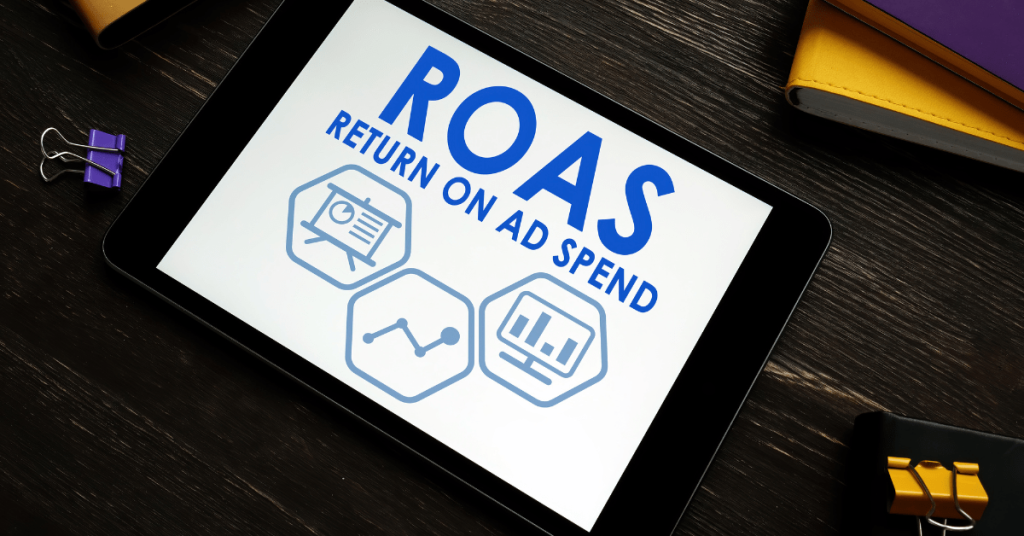
What is a good ROAS for Google Ads?
The key question regarding a good return on ad spend (ROAS) doesn’t have a single correct answer. In reality, it varies from one business to another, depending on the industry they operate in. It is dependent on the type of industry in which a business operates. When it comes to Google Ads, each campaign can have a different effect on the return generated from advertising spending. For instance, an awareness campaign may result in a fairly low number of conversions. The ratio can vary, and Google’s data shows the average is 2:1 per dollar in digital advertising revenue.
It is stated that results highly depend on the companies, and marketers believe a 4:1 value is strong to aim for. This solid target provides room for creative use of the budget. It also offers the possibility of better growth. A definitive view comes from the variety of factors, including specific goals and the general nature of the ads. A higher ratio is considered ideal because it indicates generating more investment returns.
For example, a 5 ROAS is generally excellent. Always remember that this metric helps evaluate effectiveness in the right context. As part of a broader marketing strategy, the goal is to achieve strong performance. Experts recommend that eCommerce brands follow CRO tips or consider hiring an agency to reach that level.
Key points to consider for a good ROAS:
- Important metric for Google Ads success.
- Dependent on the type of industry and business that operates.
- Awareness campaigns can result in fairly low conversions.
- The average ratio by Google’s data is 2:1 per dollar in digital advertising revenue.
- A 4:1 value provides room, a creative budget, and a better possibility.
- Higher ratios indicate generating stronger investment returns.
- Example: 5 ROAS is generally excellent.
- Part of the overall marketing strategy to achieve high results.
- eCommerce brands should follow CRO tips or think about hiring an agency.
Common Mistakes When Measuring ROAS
- Not tracking all conversions in Google Ads, including form fills, purchases, calls, and events, which causes inaccurate performance data.
- Ignoring customer lifetime value (LTV), lowering the probability of understanding the true return on investment.
- Comparing ROAS without profit margins, which affects bidding, budgeting, and targeting decisions.
- Failing to integrate analytics tools like Google Analytics or tracking software, missing valuable, real-time insights.
- Overlooking campaign channels and ad formats, limiting audience reach, and reducing placement effectiveness.
- Not adjusting targeting for audience groups, lowering ad relevance and click-through rates.
- Poor optimization of landing pages, website speed, headlines, calls-to-action, and layouts, which decreases conversions.
- Skipping keyword research and ignoring high-intent search terms, resulting in lower engagement.
- Not defining clear goals or focusing on audience behavior, creating a weak advertising strategy.
- Forgetting to test ad combinations across locations and devices, missing opportunities to improve revenue.
ROAS vs ROI
Return on Ad Spend (ROAS) and Return on Investment (ROI) are key performance metrics for marketers running advertising campaigns. Both measure revenue, cost, and profit but in different ways. ROAS is easier to calculate and focuses on advertising efficiency, while ROI considers net profit after cost, goods sold, and allocated operational cost. This difference in methodology determines how companies and organizations assess campaign success.
Marketers maintain a note to assign cost to sales generated from advertisements. The accounting department applies a formula to compute ROI, including ad revenue, cost of goods, and operational expenses. ROAS is easier for optimizing ad spend promptly, especially in pay-per-click (PPC) or Google Ads campaigns. Organizations often use ROAS as a primary criterion for advertising decisions and budget allocation.
A company may face issues in assigning profit to specific advertising campaigns. The methodology depends on accounting processes and books. Processing sales information requires determining which items were sold from ads. ROI demands computing profit with a detailed methodology, while ROAS simply tracks revenue generated from marketing efforts. For digital marketing teams, ROAS is faster and simpler to compute.
Key differences include:
- ROI measures profit, cost, goods sold, and allocated operational cost for campaigns.
- ROAS focuses on revenue generated from advertising and PPC performance.
- ROI requires the accounting department, strict methodology, and detailed records.
- ROAS is easier for determining ad performance in Google Ads and Facebook Ads.
- ROI involves computing profit using a fixed formula and sales data.
- ROAS is a primary criterion for marketers optimizing advertising spend.
Conclusion
Google Ads calculating is a straightforward procedure and an essential marketing metric to determine campaign profitability. Optimizing landing pages, implementing bidding strategies, and refining audience targets can improve ROAS. Struggling ad spend can be managed with experts who help. Snowball Creations is a digital agency that primarily focuses on paid channels to make them lucrative. Use the contact form to increase and elevate success.
Return on Ad Spend (ROAS) is a metric used to measure the effectiveness of advertising campaigns. Every company should define its goal. High-margin companies can generate profit easily, while businesses with lower operating margins need a higher ROAS to avoid losses. Using the right program to compute results through analytics is important.
Choose the right model and tool for tracking. Ensure the technology calculates and provides an accurate estimate. This helps spot opportunities and improve outcomes in campaigns.
FAQs
Q1. What is ROAS in Google Ads?
ROAS (Return on Assets Sold) in Google Ads is an essential marketing metric used to determine campaign profitability. It shows how effectively your advertising spend generates revenue.
Q2. How can I improve my ROAS?
You can improve ROAS by optimizing landing pages, implementing effective bidding strategies, and refining audience targeting. Working with digital marketing experts, like Snowball Creations, can also make paid channels more lucrative.
Q3. Why is calculating ROAS important?
Calculating ROAS is important because it helps assess the efficacy of advertising campaigns. It enables companies to set clear goals, avoid losing money, and choose the right program or analytics tool for accurate tracking.
Q4. What is a good ROAS goal for my business?
The ideal ROAS goal depends on your company’s profit margins. High-margin enterprises can generate profit with lower ROAS, while businesses with weaker margins require higher ROAS to remain profitable.
Q5. Which tools can help calculate ROAS?
Tools like Google Analytics can compute ROAS accurately, provided the technology is set up correctly. Choosing the right model and tool ensures accurate estimates and helps spot improvement opportunities.
